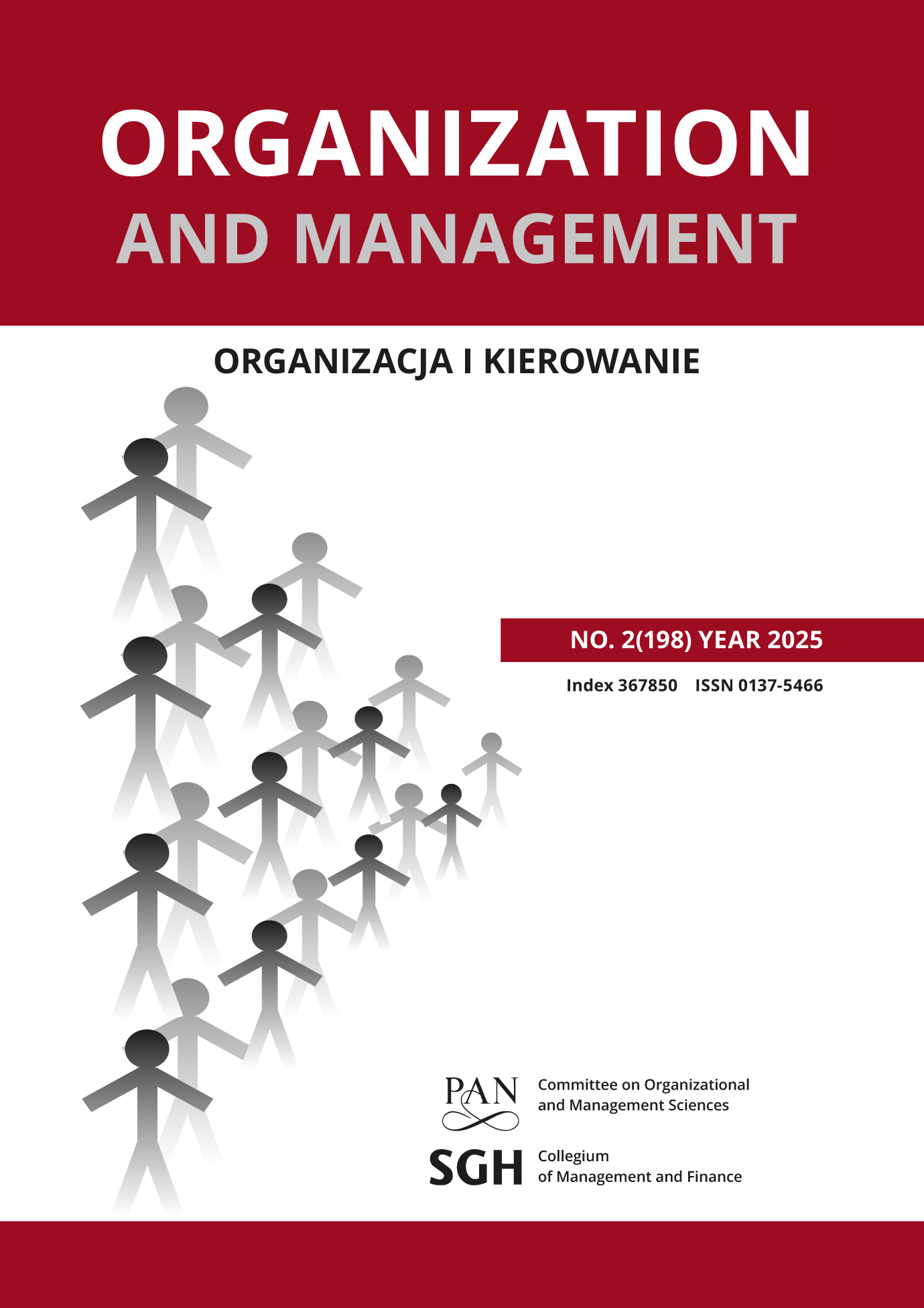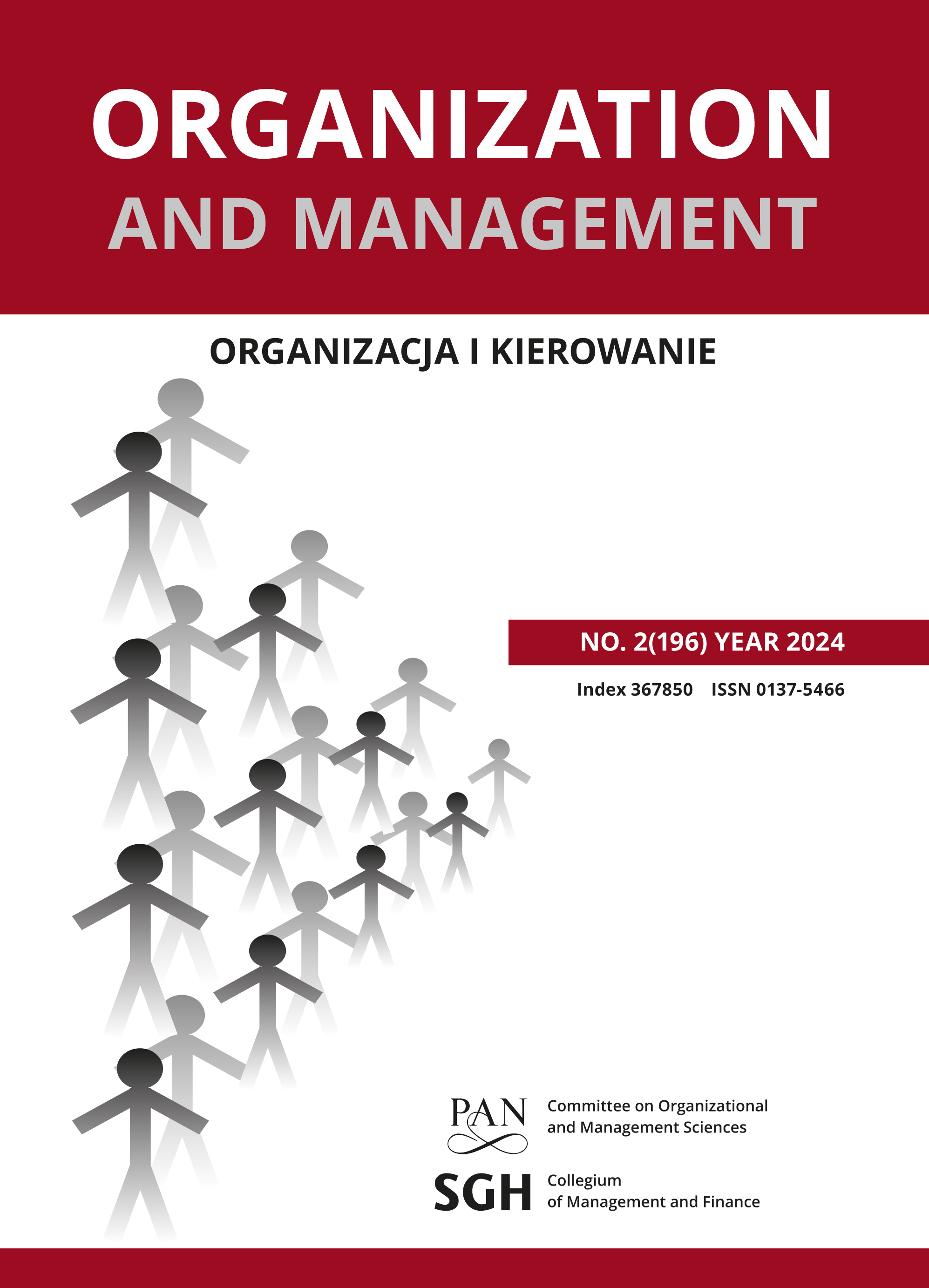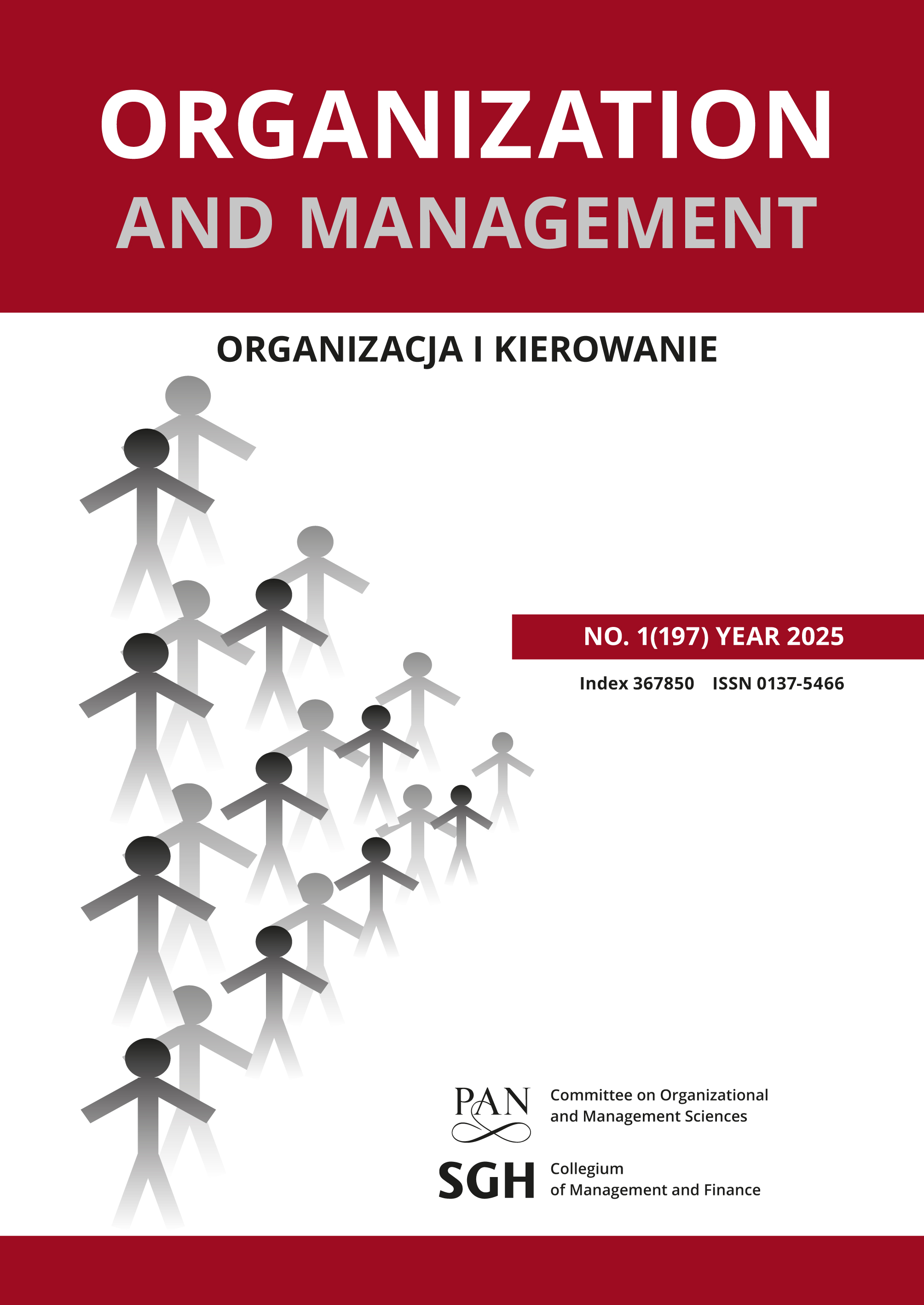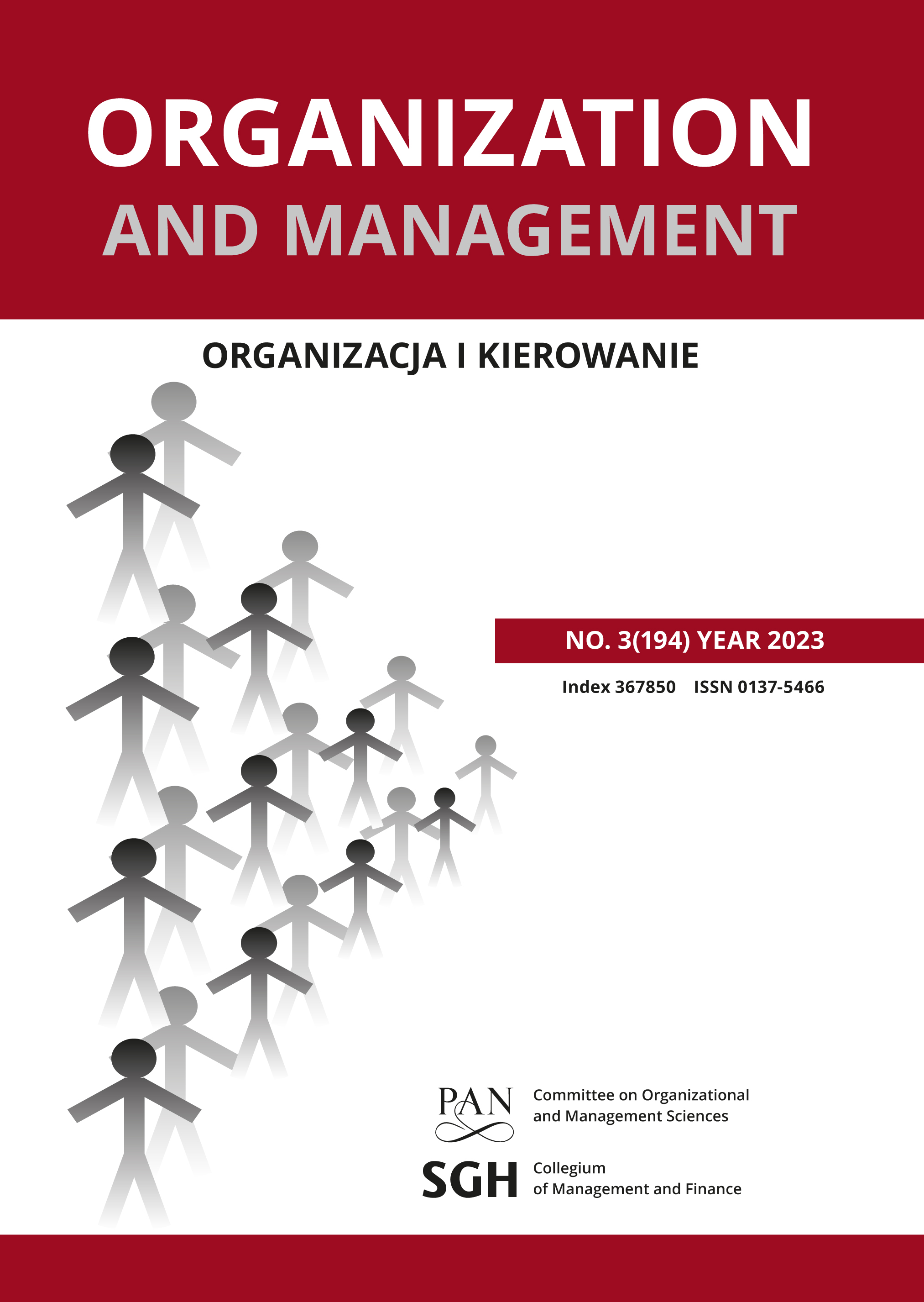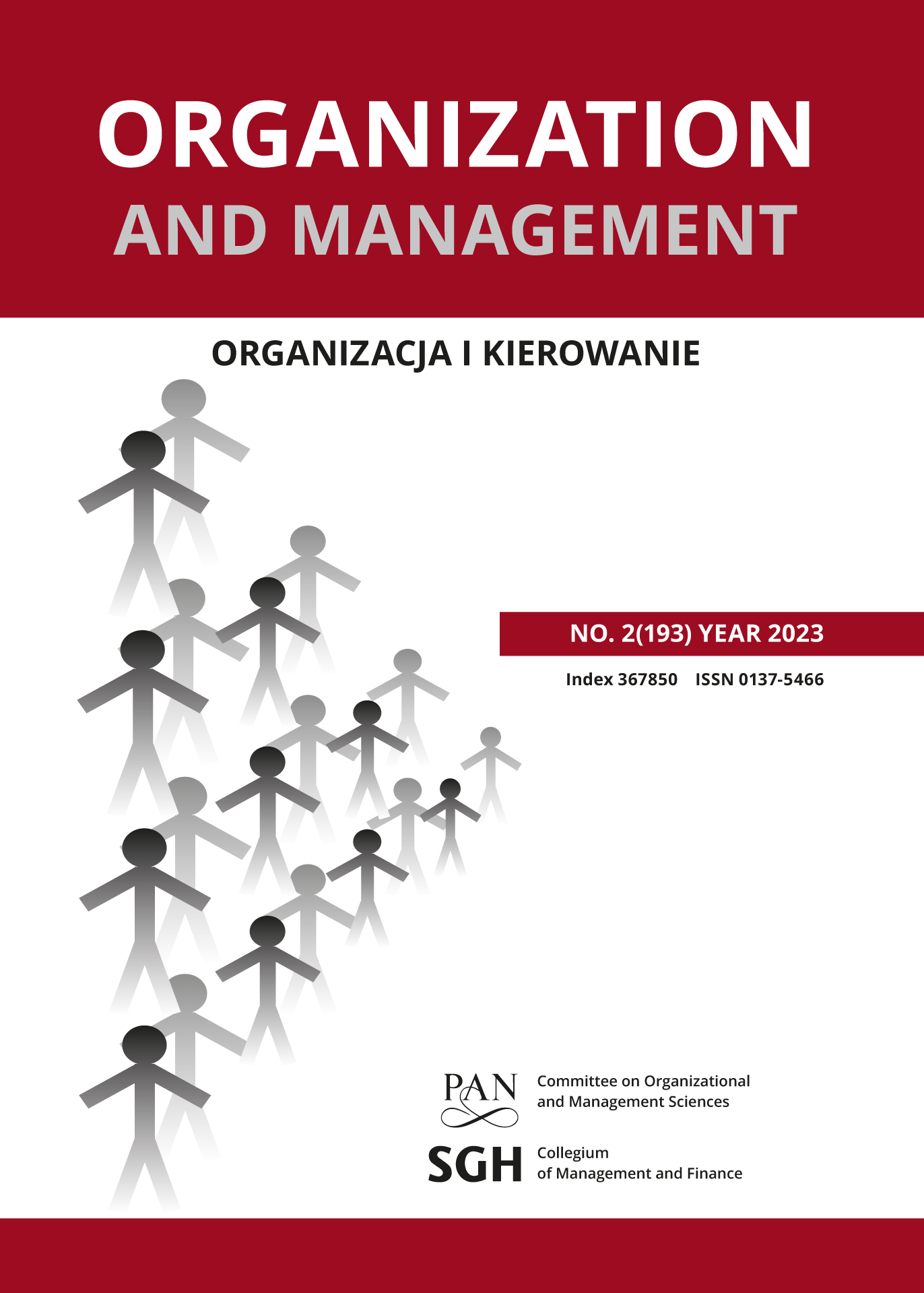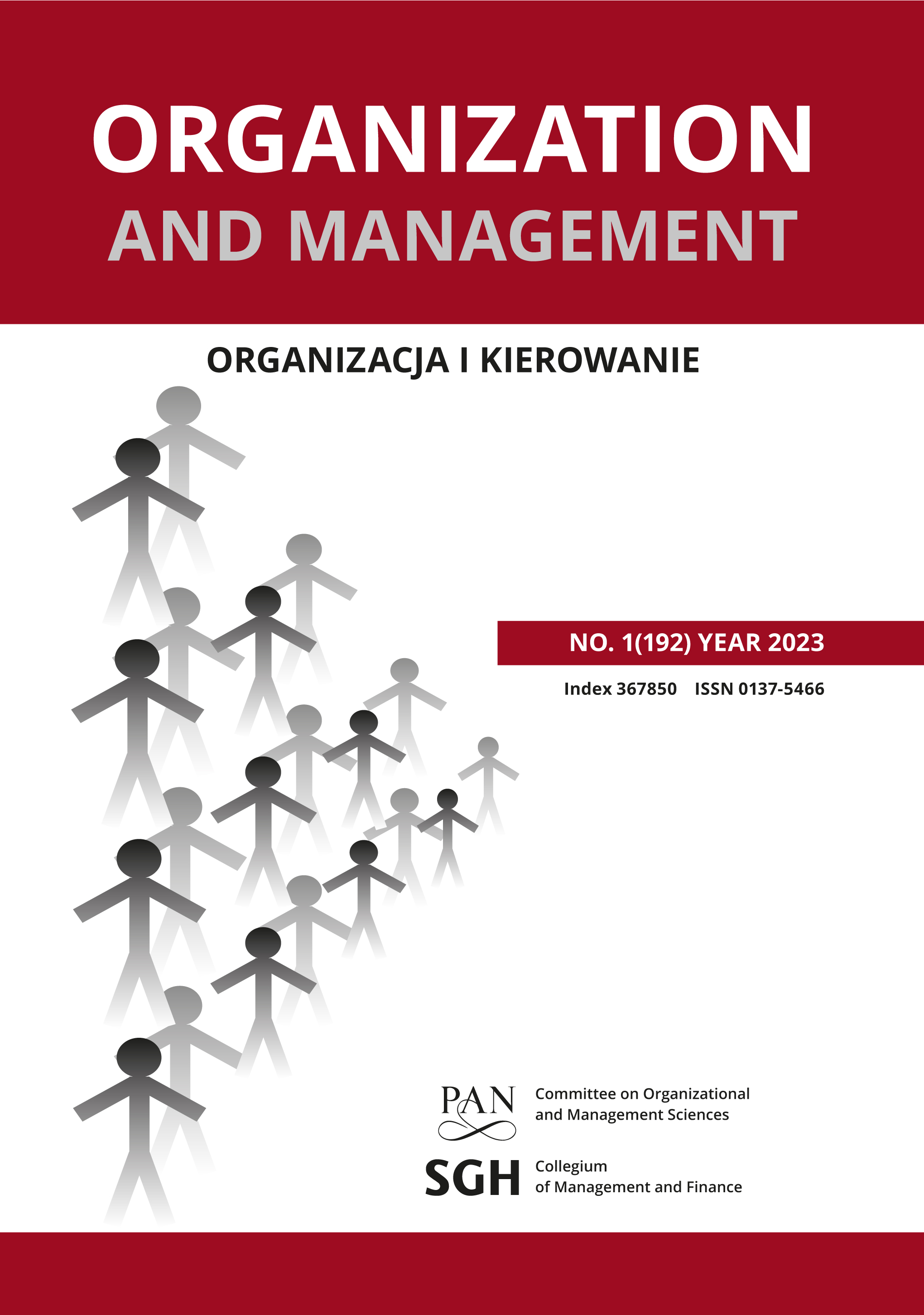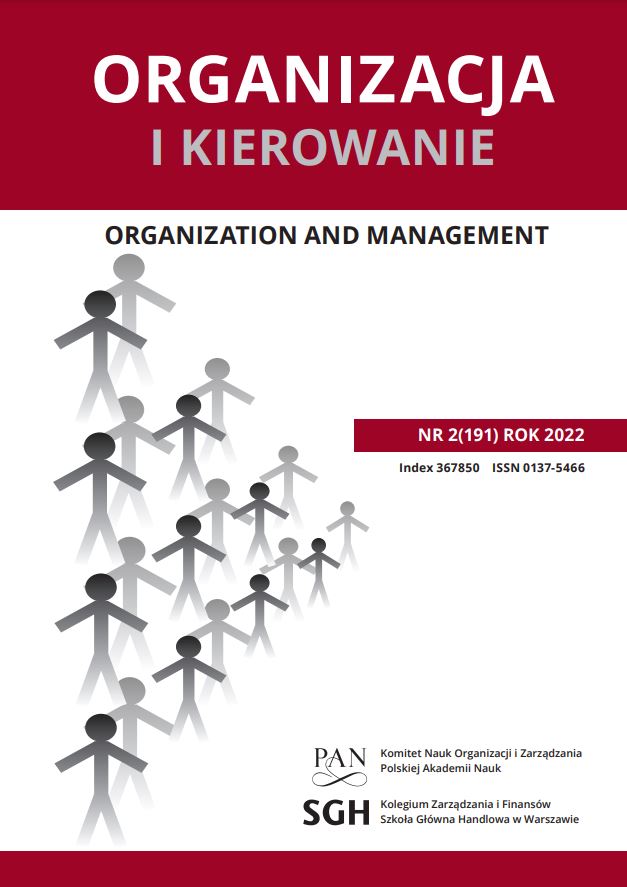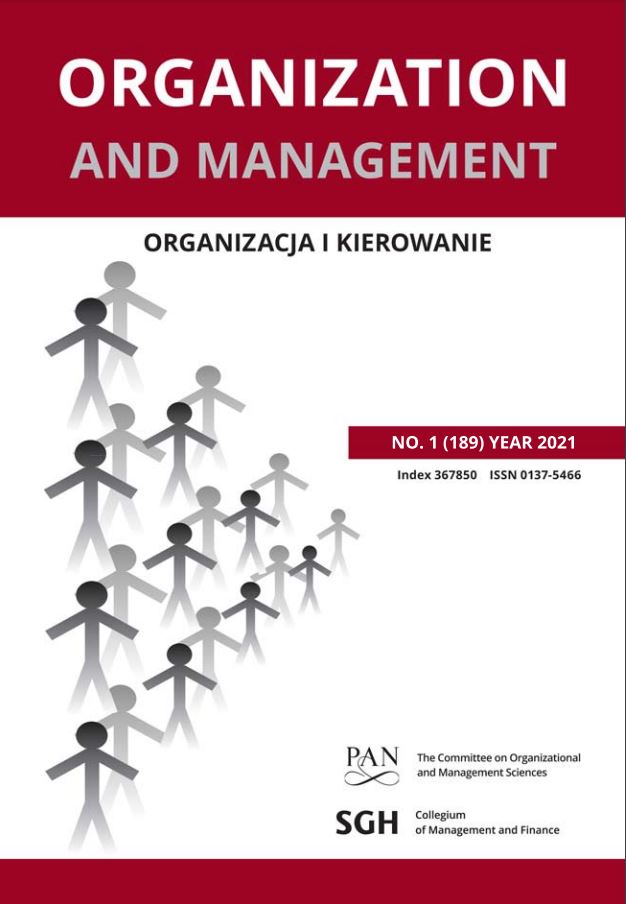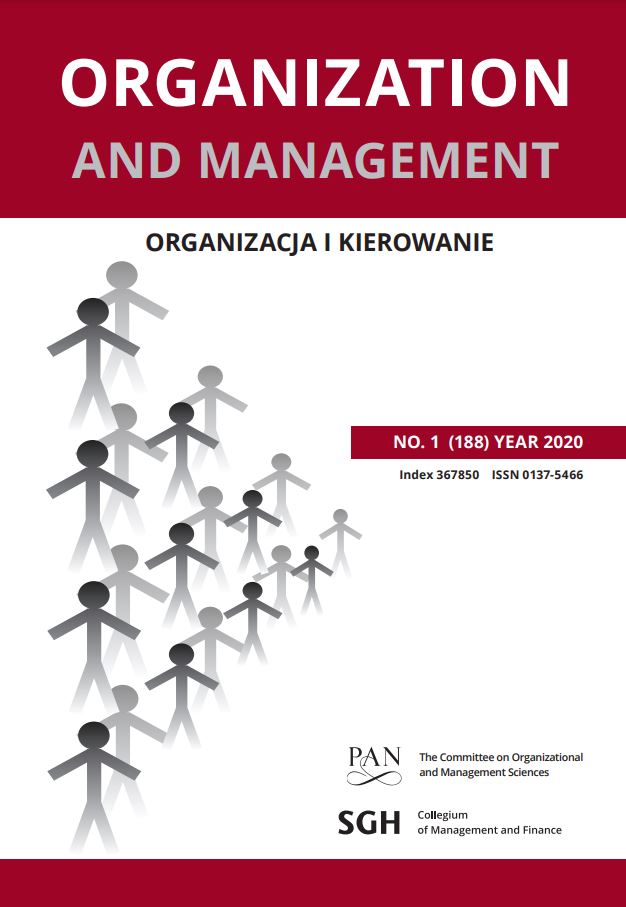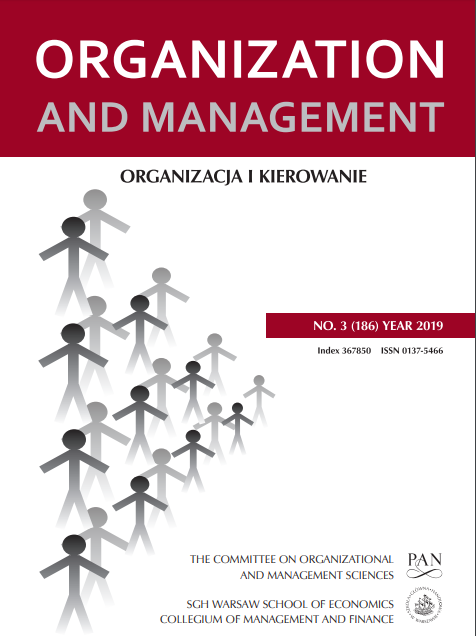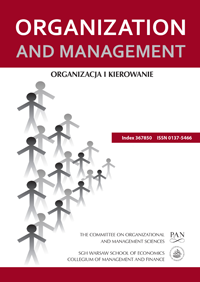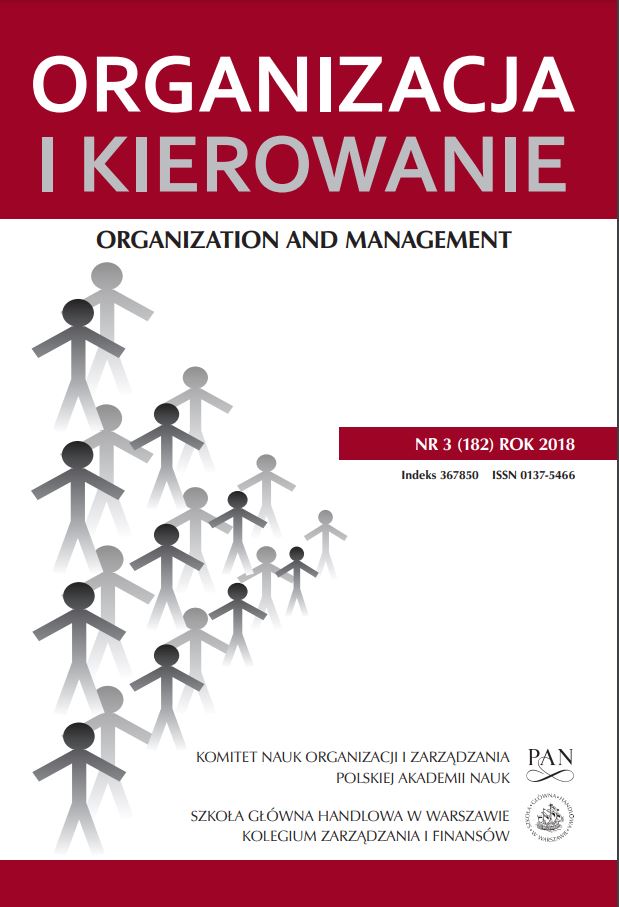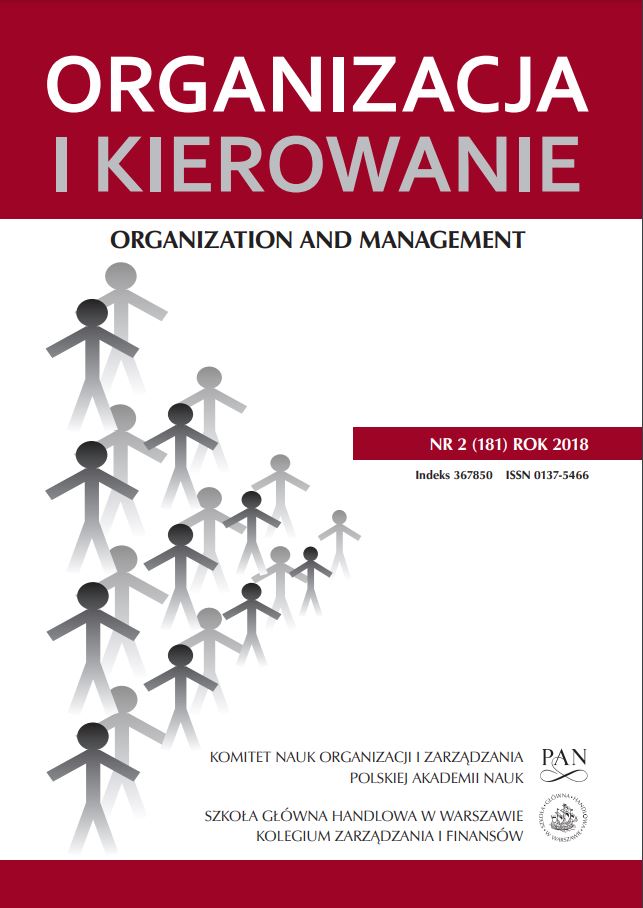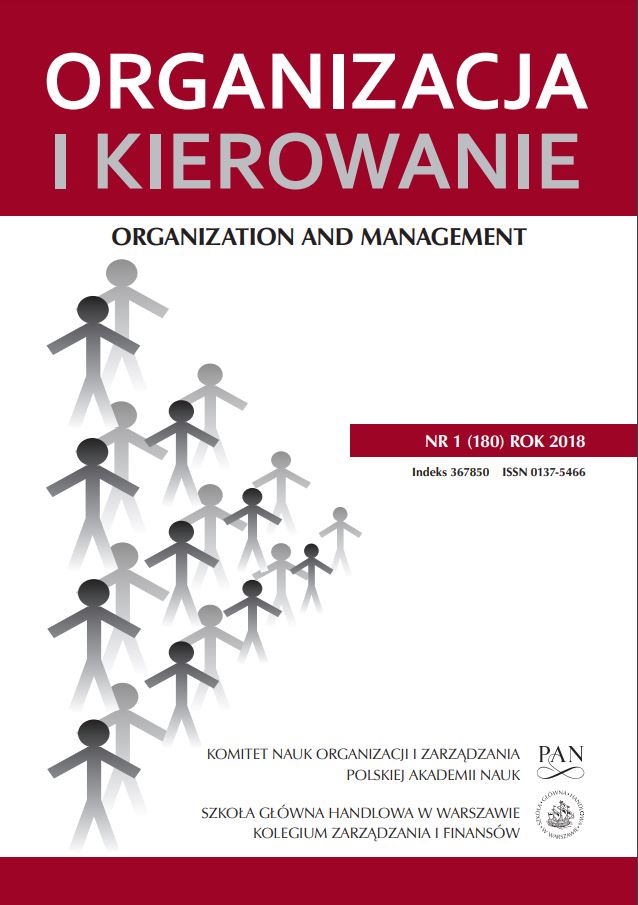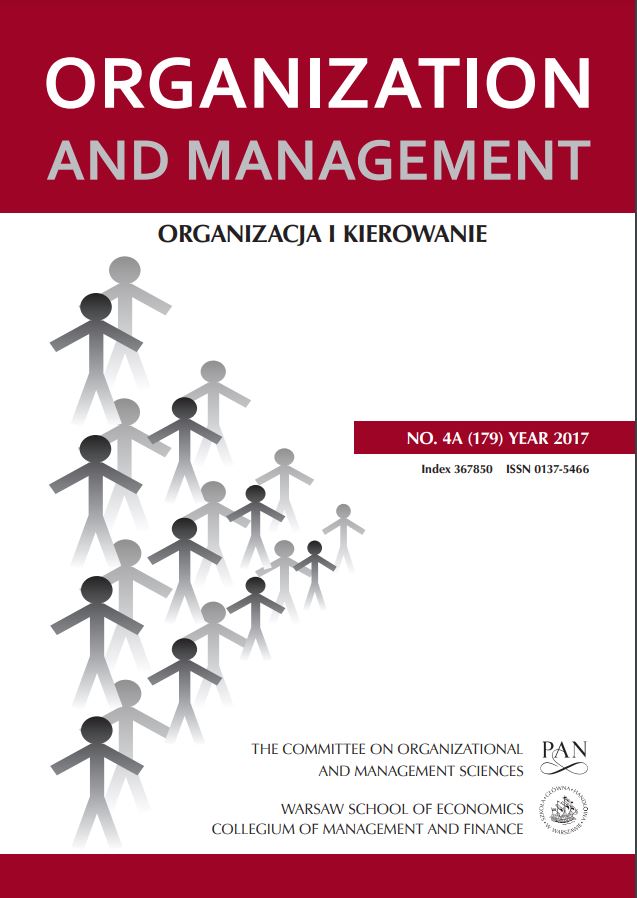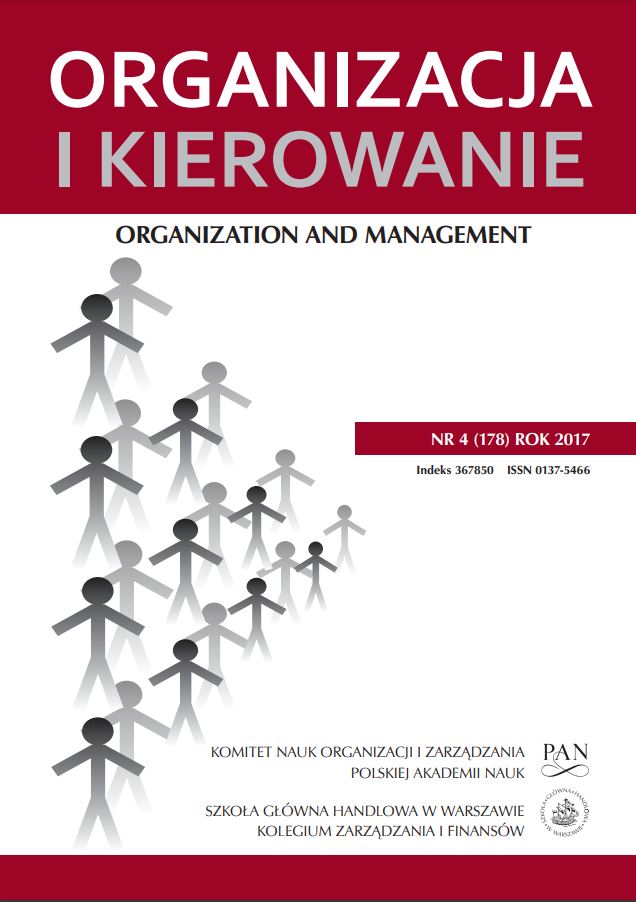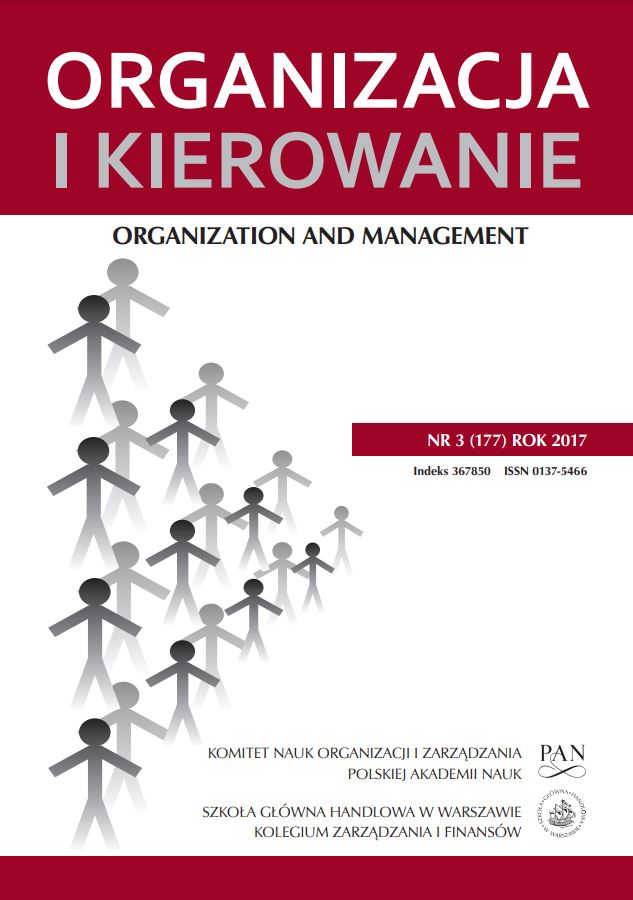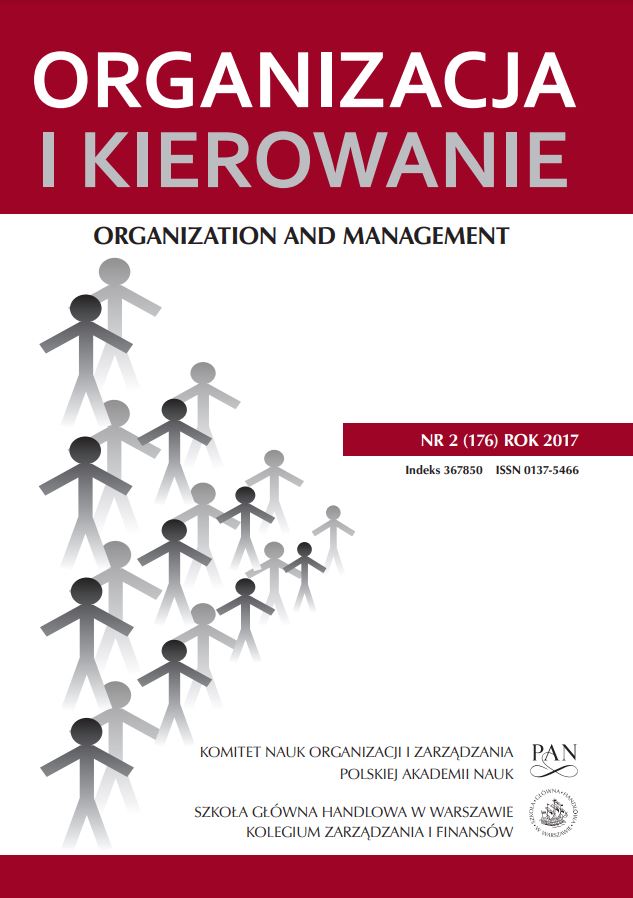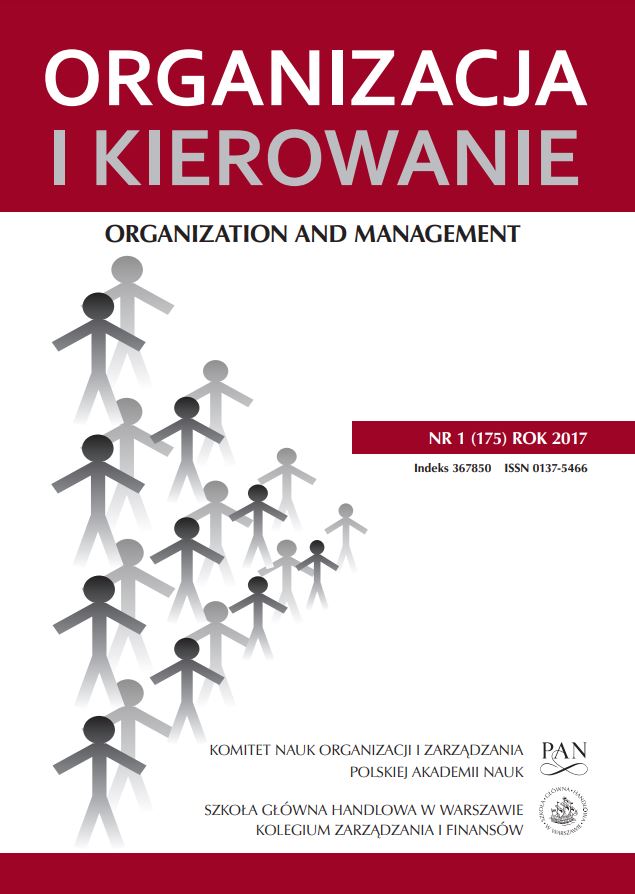Organizacja i Kierowanie
Tom 199 Nr 3 (2025)
Organizacja i Kierowanie
Tom 198 Nr 2 (2025)
Organizacja i Kierowanie
Tom 196 Nr 2 (2024)
Organizacja i Kierowanie
Tom 197 Nr 1 (2025)
Organizacja i Kierowanie
Tom 195 Nr 1 (2024)
Organization and Management
Tom 194 Nr 3 (2023)
Organizacja i Kierowanie
Tom 193 Nr 2 (2023)
Organizacja i Kierowanie
Tom 192 Nr 1 (2023)
JAROSŁAW KARPACZ
PREFACE
Ladies and Gentlemen, on behalf of the Editorial Board, I would like to invite you to read the papers included in this issue of our quarterly. All topics discussed therein are relevant to current problems.
When reviewing the findings presented therein, it is worth considering that the times are long gone when value was created by production employees and driven by progress in basic technologies. The paradigm shift brought about by the Fourth Industrial Revolution has placed highly skilled employees at the center of today’s economies in a world characterized by high volatility, uncertainty, complexity, and ambiguity. The increasing frequency of new technological solutions and breakthrough innovations
is forcing and accelerating organizations’ implementation of digital transformation processes aimed at achieving and maintaining competitive advantage, each of which places greater demands on employees. In such a situation, employee attitudes toward these changes emerge as a critical success factor: each employee may perceive the challenge of transformation as an opportunity for growth, learning, and achievement; or as a threat to routine, competence, and employment status. Therefore, the readiness of employees to acquire the knowledge and skills needed to use technology may
determine the ability to adapt to a changing environment and, consequently, determine the possibility of survival among more adaptive competitors. The environment imposes a set of constraints on an organization which it must consider in its functioning. If they are not taken into account, they may result in the organization’s failure as the environment controls resources, and the organization is more dependent on the environment when its demand for resources is greater.
Marzena Stor in her paper entitled The impact of organizational talent management on company performance results: The mediating role of HRM outcomes in MNCs headquartered in Central Europe bases on her own empirical research. This research shows that HRM (Human Resources Management) performance positively mediates the relationship between organizational talent management and an enterprise’s performance in terms of finance, quality, and innovation. Her findings indicate that this mediating effect is stronger during the pandemic period than in the pre-pandemic one. The authoress uses structural equation modelling (PLS-SEM) to verify the research hypotheses and assess the mediating effects. The study covers 200 international enterprises based in the Central Europe.
In his paper titled Differences in the approach to onboarding of leaderships talents in the HQ of MNCs before and during the COVID-19 pandemic Łukasz Haromszeki refers to talent management with specific focus on leaders. Leadership talent management is currently one of the key aspects of HRM (Human Resource Management). The paper presents findings from empirical research involving 200 enterprises (n = 200), demonstrating that the approach to the onboarding process of leadership talents has shifted before and during the COVID-19 pandemic. Under challenging conditions, onboarding is no longer seen merely as a step in filling a vacant position. Instead, it involves a comprehensive analysis of various aspects of leadership relationships and a deeper understanding of the needs, expectations, and behavior measurements. Descriptive statistics, correlations, and principal component analysis (PCA) are used therein to analyze the obtained data.
The paper authored by Elżbieta Kowalczyk, Gabriela Roszyk-Kowalska, and Anna Cedro titled Competency-based professional development in shaping affective organizational commitment also fits into the area of human resource management. It proves the existence of a relationship between professional competences and affective organizational commitment. The authors also indicate that career development and promotion opportunities are key mediators in this relationship. Their findings reveal that these mediators significantly explain the relationship between competencies and
the affective organizational commitment of fire fighters at all levels of the organizational hierarchy. The adopted research procedure includes Baron and Kenny’s mediation analysis, which helps to verify research hypotheses and formulate recommendations for practice. It is worth adding that the results presented in this paper may constitute, in the authors’ opinion, an important incentive for subsequent researchers to discover other, hidden and non-obvious mechanisms of dependencies in the area of organizational behavior, especially since this issue has not been extensively explored in prior studies.
The issue of human resource management is continued by Dominika Miliszkiewicz in her paper titled Virtual teams’ domain: In need of attention. However, in this case, her research attention is focused on virtual teams. By using a literature review, she determines the popularity of such teams’ work in the post-COVID reality. She points out that, according to her findings, this topic is less frequently explored by researchers than that relating to IT project management. Despite this, she believes that remote
work will remain in practice a widely used way of performing work duties.
Michał Bańka, Mariusz Salwin, Magdalena Marczewska, Monika Sychowicz, Joanna Kłos, and Szymon Rychlik’s paper entitled Startup accelerators: Research directions and gaps is directed at systematizing the knowledge on start-up acceleration. It analyses the current state of knowledge on start-up accelerators, mapping and synthesizing current research efforts, as well as identifying gaps and opportunities for further research. As far as methodology is concerned, the authors use the results
of a systematic network analysis combining a systematic literature review with literature network research. A comprehensive review of research findings is developed through the use ofthe Scopus database. A bibliographic network analysis is performed using the VOSviewer and focuses on a manually selected group of research papers. A visualization of the co-citation network is analyzed and created with Citespace. In the authors’ opinion, none of the papers included in the Scopus database are intended to provide a comprehensive analysis of start-up acceleration and systematize the
achievements of researchers in this area.
Kamila Szproch-Dziopa presents the evolution of the concept of “corporate social responsibility” in the paper under the title of Corporate social responsibility: Changes in perception of the concept in theory and practice. The results of the literature review make it possible to demonstrate differences and similarities in the way this term is understood by both researchers and practitioners. Consequently, she answers the question of how changes in the perception of CSR by practitioners influence its
definition by scientists and vice versa – whether changes in the scientific approach to CSR generate the evolution of this construct in practice. The authoress reveals a common feature of all approaches, which is the need to establish a relationship between the enterprise and the environment in which it operates, as well as the fact that the group of stakeholders interested in CSR is constantly growing. She also states that increasingly easier access to information and growing social awareness will mean
that the dialogue conducted within the framework of socially responsible business will cover an increasingly broader spectrum of issues.
Urszula Kobylińska’s paper, titeled Antecedents of scientists’ engagement in cooperation with industry also focuses on the spirit of enterprise’s relationship with its environment. In its content, the authoress identifies the individual characteristics of scientists, as well as the organizational and institutional context and other conditions affecting the cooperation between scientists and enterprises. These
interactions include joint research with enterprises, contract research, consultancy, and more informal activities, such as consulting, training, as well as networking with business practitioners. The considerations presented therein reveal that most of the research attention is focused primarily on commercialization channels, ignoring other important forms of relationships which may be established at the interface of these two important sectors.
I encourage you to read these papers, hoping they will inspire you to research and discussions in our journal. We would like to promote new knowledge and methods among scientists and practitioners. Therefore, on behalf of the Editorial Team, I would like to encourage you to disseminate the research findings in the fields of management and quality sciences, economics, and finance in our journal. We are here to support you.
Organizacja i Kierowanie
Nr 2 (191) (2022)
Organizacja i Kierowanie
Nr 1 (190) (2022)
Organizacja i Kierowanie
Nr 1(189) (2021)
Organizacja i Kierowanie
Nr 1(188) (2020)
Organizacja i Kierowanie
Nr 4 (187) (2019)
Preface by Editor-in-Chief
prof. dr hab. Maciej Urbaniak
By releasing the last issue of our magazine this year, we hope you will read it in the festive atmosphere of the upcoming Christmas and New Year. We hope that this reading will inspire you, and especially potential authors, to new ideas for interesting scientific texts that we will be able to publish in our journal.
In the first article Bogdan Nogalski and Przemysław Niewiadomski made an attempt to assess the level of technological maturity that implies the implementation of an imitation strategy. To achieve this goal, the authors were carried out the studies among manufacturers operating in the agricultural machinery sector. In carrying out the research they used method of literature studies, expertise, a creative discussion, participant observation as well as providing opinions with the use of a self-assessment questionnaire. The results of these studies indicate that the agricultural machinery sector is dominated by enterprises, which inspired by innovations and observing a pioneer, focus on competitive, efficient and mature imitation.
Marek Jabłoński and Bernard Ziębicki have presented the essence of operation of automation of accounting processes solutions and their benefits as well as hazards, in the light of research performed so far. To realize this goal the authors used consulting companies’ research reports and the results of surveys with employees of Cracow shared services centers. Based on the results of these research one could state that automation does change the nature of work of a contemporary finance specialist, reducing routine works, in place of which they can concentrate on strategic tasks, interactions with stakeholders, formulating conclusions on the basis of analysis of information, in order to improve business performance. Technological progress and
automated processes give professionals more time to act in the strategic area and become true business partners.
In her article Izabela Bednarska-Wnuk tried to identify the conceptualization of the essence of the notion of entrepreneurial mobility, to determine its dimensions and to show the relationship with strategic entrepreneurship, the theory of resources and the theory of entrepreneurial behavior. The obtained conclusions authorize to state that entrepreneurial mobility undertaken by enterprises may also be, thanks to possessed resources, competencies and the use of opportunities in the environment an essential moderating factor in maintaining and/or achieving a competitive advantage.
In the next article Marek Jabłoński made attempt to investigate occupational tasks and wage inequality over last decade in the one of Poland’s municipal companies. In particular, the study, conducted in the reference to data from the 2009 and 2018 year, aimed to identify the changing share of particular types of jobs according to the adopted classification and to analyze individual pay scales from the perspective of the identified types of positions. The research procedures were based on document analysis, structured interviews, team work methods, and classification technique.The results indicate a decrease in the share of routine in favor of non-routine jobs.
In the last article Katarzyna Magdalena Rozbejko dealt with a problem related to flexibility and efficiency in the applied management style on the example of managers in the banking sector.Analyzing the problem, she conducted the survey with managers in this sector. The author positively verified the hypotheses which assume that firstly managers in the banking sector are characterized by flexibility in applying the management style and secondly, the greater the flexibility in using management styles the higher the subjective assessment of the efficiency of managing people.
On the occasion of Christmas and New Year, I would like to convey to you the wishes of many successes in professional and personal life, and I also have great hope for cooperation in the atmosphere of the widest possible internationalization of our journal.
Enjoy your reading,
Maciej Urbaniak
Organization and Management
Nr 3 (186) (2019)
Preface by Editor-in-Chief
prof. dr hab. Maciej Urbaniak
We have a great pleasure to pass the third issue of our magazine this year. The current issue is devoted to particularly important problems concerning human resource management.
In the first article Anna Rogozińska-Pawełczyk presented her reflections on significance of the psychological contract for the relationship between high effective human resource management systems and employee productivity. Based on the research, author has found that the high-effective human resource management systems (expressed by content, process and climate) affect employee productivity, both directly and indirectly – through the intermediary role of a psychological contract (expressed by the employer and employees through fulfilling mutual promises).
Agata Borowska-Pietrzak in her study points to determinants and conditions of the personnel function which shape a sense of professional satisfaction. Results of the empirical studies presented in this article indicate that the high-quality level of the modern personnel function determines the increase of the sense of professional satisfaction. Author also notices that sources of this satisfaction (subjective attributes) are quite diverse and do not depend directly on HRM quality in the organization.
Dariusz Turek tried to describe how and in what situations HRM practices may contribute to counterproductive behavior. Based on the cognitive framework of employee behavior in the organization, it was assumed that negatively perceived human resource management practices may indirectly affect the counterproductive behavior of employees. Author indicates, based on the results of empirical research,
the important role of human resource management practices in counteracting counterproductive behavior and building a professional climate. He also indicates the need for longitudinal research, which will better explain the nature of the impact of the HRM system on the activity of employees in the professional environment.
Marcin Wnuk in his article presented the result of the study in which he verified the mechanisms of the impact of perceived support received from the organization and supervisor, gratitude and organizational loyalty on the affective commitment of employees and the desire to leave it. Research results confirmed the existence of mechanisms of impact of perceived support received from the supervisors and perceived support received from the organization on the employee’s attitude towards the organization and the key role of gratitude and loyalty for shaping affective commitment.
In the last article, Katarzyna Januszkiewicz tried to describe the relationship between cognitive and behavioral aspects of the flexibility of organizational behavior of employees. In the course of interesting empirical analyzes, the author showed that there is a statistically significant relationship between the self-assessment of flexibility and the frequency of occurrence of a given behavior.
Enjoy your reading
Maciej Urbaniak
Organization and Management
Nr 2 (185) (2019)
Preface by Editor-in-Chief
prof. dr hab. Maciej Urbaniak
The current issue of our Quarterly concerns several contemporary topics such as: relational capital of clusters, interpersonal conflicts in workplace and work engagement, personal branding, functional flexibility in organizations as well as robotization of business processes.
In the first article Beata Chmielewiec analyzes the importance of cluster relational capital as a factor increasing its competitiveness and then formulates guidelines for the creation of a relationship management strategy in a cluster organization. The article defines a cluster, presents the essence of relational capital concept and its impact on the competitive position of cluster participants. The author also proposes a procedure for creating a comprehensive strategy for building the relational capital in the cluster.
Tomasz Gigol presents in his paper results of quantitative questionnaire study on conflict management in the workplace and work engagement. Research results reinforce skepticism about the frequent conflict management style through avoiding or yielding. If employee engagement is a desirable state in an organization, active conflict management should not be disregarded. A postulated practical conclusion from the study is that active conflict management should be taught in training programs for managers and academic courses for future managers.
The article of Małgorzata Sidor-Rządkowska provides analysis of the inter-relationships between the notions of “employer branding’’ and “personal branding’’. It is argued that the contemporarily observed changes in the approach to building professional career require undertaking actions both in the area of employer branding and personal branding.
The article by Anna Biłyk is an attempt to answer the question how functional flexibility is implemented in organizations where self-organization is functioning. To answer this question, the author conducted qualitative research in the form of a case study. The results of this study indicate the presence of functional flexibility elements that manifest themselves in such forms as enriching or expanding the scope of work;
however, they are located in a specific organizational context.
The next paper in this issue written by Piotr Sliż is concerned with problem of robotization of business processes. The article presents the results of the analysis of the popularity of the robotic process automation related entries using the Google Trends tool. Research shows a growing interest in the issues of the robotic process automation in the field of management and quality sciences, as well as business practice.
Katarzyna Klimkiewicz and Ewa Beck-Krala in their paper conducted an analysis of how HR managers perceive the role of rewards systems in relation to the principles of corporate social responsibility and the process of creating a sustainable organization. The results of this analysis showed that employers use incentive programs supporting CSR goals and activities, such as: paid time for employee voluntary activities, financing
employee charity initiatives outside the working time e.g., employee participation in charity football/volleyball games, encouraging employees to initiate events directed towards local community, encouraging employees’ participation in implementation of CSR goals and activities, offering incentive programs related to pro-ecological goals.
Enjoy your reading,
Maciej Urbaniak
Organization and Management
Nr 1(184) (2019)
Preface by Editor-in-Chief
prof. dr hab. Maciej Urbaniak
As we have already announced, the edition of our magazine starting from the
beginning of 2019 will be published only in English.
The current issue of our Quarterly concerns several contemporary topics such as: socially responsible innovations, instruments of the organizational communication systems, autonomy in human resources management, organizational politics and change as well as the role of a manager in managing intellectual capital.
Agata Austen and Monika Rutkowska in their paper discussed factors that may influence researchers’ absorptive capacity. A review of literature indicates that traditional role of universities, limited to education and undertaking research activities focused primarily on the development of scientific theories, has evolved towards the requirement of innovation and active search for opportunities to commercialize research results. Among many factors determining the innovativeness of researchers and their ability to commercially exploit research results, the importance of researchers’ absorptive capacity (ACAP) has been increasingly stressed.
In the next article Seweryn Spałek and Remigiusz Kozubek point to the designatum of the term socially responsible innovations in order to identify the research area. The authors attempt to show an operational definition of socially responsible innovation based on the integration of innovation theory and elements relating to the concept of sustainable development, corporate social responsibility.
Michał Chomicki indicates a relationship between the organizational communication system of Polish companies and the beneficialness of the shape of the cooperative relations between these companies and particular kinds of cooperators. The results of the author’s research show that organizational communication system and its instruments influence the beneficialness of the shape of cooperative relationships.
Agnieszka Górka-Chowaniec presents in her paper the basic role of managers in managing the human capital and brings closer the essence of autonomy of personnel in the human resources management. The author verified the hypothesis about the importance of autonomy in human resources management and its impact
on the efficiency of the work of individual employees. The results confirm the main hypothesis leading to the conclusion that the increase of the decision participation of individual members of the organization in their duties can significantly contribute to rising the efficiency of the services provided.
Barbara Siuta-Tokarska, Ryszard Borowiecki and Tomasz Kusio analyzed the role of a manager in managing intellectual capital in the context of innovative projects in an enterprise. The authors presented a cross-sectional analysis of case studies (of various size enterprises) presenting the role of the human factor in the context of intellectual capital management.
The Editorial Board asks Potential Authors for the texts of your considerations to be embedded in the international context of the latest scientific trends, and the cited literature to include studies in English (also studies published in our country). We ask for professionalism in the scope of the studies provided to us, which should be a subject of a thorough linguistic correction before submitting them to our Editorial Office. The lack of due diligence of the Authors in this regard will result in the refusal to accept the text and to forwarding it to the assessment by foreign reviewers. We want the particular issues to be characterized by thematic consistency and high professionalism in line with current trends in international journals.
We hope that each of your articles characterized by high quality content and properly drafted in the English version (including a native copyreader), will contribute to the growth of the citation index in international journals’ databases.
Wishing you in 2019 many successes in your professional and personal life!
Maciej Urbaniak, Editor in Chief
Organizacja i Kierowanie
Nr 4 (183) (2018)
Organizacja i Kierowanie
Nr 3 (182) (2018)
Organizacja i Kierowanie
Nr 2 (181) (2018)
Martyna Wronka-Pośpiech, Marta Tutko
Organizacja i Kierowanie
Nr 1 (180) (2018)
OD REDAKTORA NACZELNEGO
Katarzyna Byrka-Kita, Mateusz Czerwiński, Agnieszka Preś-Perepeczo, Tomasz Wiśniewski
ZMIANA NA STANOWISKU PREZESA ZARZĄDU NA POLSKIM RYNKU KAPITAŁOWYM
Streszczenie
Celem przeprowadzonych badań była analiza skali zjawiska tzw. sukcesji na stanowisku prezesa zarządu na polskim rynku kapitałowym w kontekście cech, takich jak: wykształcenie, powiązanie ze spółką, doświadczenie sektorowe i funkcjonalne, płeć, a także charakterystyka okoliczności sukcesji oraz liczebność zarządu. Badaną populację stanowiły powołania prezesa w spółkach publicznych, których akcje były dopuszczone do obrotu na GPW w Warszawie SA w latach 2000–2015. W wyniku dokonanego przeglądu literatury nie zidentyfikowano jak dotąd tak szczegółowej analizy zjawiska w odniesieniu do polskiego rynku kapitałowego. Populacja badawcza w liczbie 1904 powołań na stanowisko prezesa, w tym 886 nowych sukcesji, stanowi podstawę do odrzucenia hipotezy, że to skala zjawiska stanowiła w przeszłości czynnik mniejszego zainteresowania tym zagadnieniem wśród polskich badaczy. Na podstawie przeprowadzonej analizy w ramach statystyki opisowej populacji można zauważyć, że charakterystyka polskiego prezesa odbiega od opisu „typowego” prezesa na innych rynkach kapitałowych, co można uznać za przyczynek do dalszych rozważań nad zjawiskiem. Wyniki mogą mieć wpływ na proces podejmowania decyzji w odniesieniu do osób pełniących najwyższe stanowiska w spółkach oraz ułatwić wyjaśnienie związków między rotacją na stanowisku prezesa a wartością rynkową podmiotów notowanych na giełdzie. Rezultaty badań powinny zainteresować zarówno kadrę zarządzającą, organy nadzoru właścicielskiego, instytucje nadzorujące rynek finansowy, jak i ustawodawcę w kontekście parytetów płci w organach spółek kapitałowych. Analiza, obejmując pełen cykl giełdowy wraz z kryzysem finansowym oraz bańką internetową, wypełnia lukę badawczą dotyczącą rynków Europy Środkowej i Wschodniej.
Słowa kluczowe: prezes zarządu, CEO, sukcesja, zarządzanie, rynek kapitałowy
CEO TURNOVER IN THE POLISH CAPITAL MARKET
Abstract
The purpose of the research was to analyse the phenomenon of succession in the managing director position (CEO) in the Polish capital market in the context of such characteristics as education, association with the company, sectoral and functional experience, sex, as well as the characteristics of the succession and the size of the board. The researched opulation constituted the CEO’s appointments in public companies, whose shares were traded in the Warsaw Stock Exchange in 2000–2015. As a result of the literature review we identified that no such detailed analysis of the CEO successions has been performed in relation to the Polish capital market. A number of 1904 CEO appointments, including 886 new successions, are the basis for rejecting the hypothesis that the scale of the phenomenon has historically been a factor of less scientific interest in the issue among Polish researchers. Based on the analysis conducted within the descriptive statistics of the population, it can be noted that the characteristic of the Polish CEOs differs from the description of the “typical” CEO in other capital markets, which can be considered as a contribution to further research of the henomenon. The results may influence decision-making processes in companies and lead to a better understanding of how the CEO appointment process can impact market value. The findings can be used by both the owners and supervisory boards. They may influence the decisions to appoint top executives and contribute to a better understanding of how a CEO appointment impacts shareholder value creation. The results also provide important guidelines for institutions that oversee the financial system and legislator in the context of the gender parity. The study covers a full economic cycle of the capital market, including the financial crisis and bubble periods and fills a research gap regarding developing markets in Central and Eastern Europe.
Key words: ceo, succession, management, capital market
Zjawisko odkładania pracy na później nie dotyka wyłącznie pojedynczych pracowników, ale jest zachowaniem szeroko rozpowszechnionym, niemal wpisanym w ludzkie funkcjonowanie. Badania A. H. C. Chu i J. N. Choi [3] rzuciły nowe światło na to zagadnienie, koncentrując uwagę badaczy na dwóch różnych rodzajach zachowań prokrastynujących. W związku z tym celem badań prezentowanych w niniejszym artykule jest przeprowadzenie analizy związków między wzmiankowanymi rodzajami odkładania pracy na później (aktywnym vs biernym) a klimatem organizacyjnym danej firmy. W badaniu uczestniczyło 119 osób (71 kobiet i 48 mężczyzn), które zostały poproszone o wypełnienie trzech narzędzi badawczych: Kwestionariusza Klimatu Organizacyjnego, Skali Prokrastynacji Aktywnej i Ogólnej Skali Prokrastynacji. Otrzymane wyniki wskazują, że w klimacie autokratycznym pracownicy częściej mogą odwoływać się do biernego odkładania pracy na później, z kolei w klimacie wspierającym mogą częściej aktywnie odkładać pracę. Ponadto zaobserwowano związki między różnymi wymiarami klimatu organizacyjnego a aktywną i bierną prokrastynacją.
Słowa kluczowe: klimat organizacyjny, aktywne odkładanie pracy na później, bierne odkładanie pracy na później
The phenomenon of procrastination does not only affect individual workers, but is a quite common behavior almost inscribed in human functioning. A. H. C. Chu and J. N. Choi [3] have shed a new light on this issue, focusing the attention of researchers on two different styles of procrastinating behavior. Consequently, the purpose of the research presented in this paper, is to analyze the relationship between the procrastination styles (active vs passive) and the organizational climate. The study involved 119 participants (71 women and 48 men) who were asked to complete three research tools such as: the Organizational Climate Questionnaire, the New Active Procrastination Scale and the General Active Procrastination Scale. The results revealed that, in an autocratic organizational climate employees are more likely to refer to passive procrastination, while in a supportive organizational climate they can more actively postpone their work. In addition, relationships between different dimensions of organizational climate and active and passive procrastination were observed.
Key words: organizational climate, active procrastination, passive procrastination
INNOWACYJNOŚĆ PRZEDSIĘBIORSTWA W LOKALNYCH I ZAGRANICZNYCH RELACJACH KLIENT–DOSTAWCA
Celem artykułu jest analiza zależności między efektami działalności innowacyjnej przedsiębiorstwa a rodzajem relacji z kluczowymi klientami i dostawcami w zależności od ich krajowej lub zagranicznej lokalizacji. Dla realizacji celu przedstawiono wyniki badań własnych przeprowadzonych od listopada 2014 r. do czerwca 2015 r. wśród 419 przedsiębiorstw z Polski i przeanalizowanych metodą skupień. Badania wykazały, że przedsiębiorstwa cechujące się prawie takim samym poziomem innowacyjności, a wręcz nieznacznie niższym niż u konkurentów, tworzą relacje z kluczowymi klientami zlokalizowanymi zarówno zagranicą jak i w Polsce, a ich kluczowi dostawcy pochodzą z kraju. Z kolei wśród podmiotów cechujących się lepszym niż u konkurencji poziomem innowacyjności dominuje współpraca z zagranicznymi i polskimi kluczowymi dostawcami oraz kluczowymi klientami zlokalizowanymi na terenie kraju. Przeprowadzona analiza pozwala wskazać tendencje w zakresie internacjonalizacji działalności innowacyjnej przedsiębiorstw.
Słowa kluczowe: innowacje, innowacyjność, relacje, nabywcy, dostawcy, współpraca
The aim of the article is to analyze dependency between effects of companies’ innovation activity in terms of their relationships with key customers and suppliers according to their domestic or foreign location. In the article the results of the study conducted from November 2014 to June 2015 among 419 companies from Poland are presented and analyzed using cluster method. The analysis shows that companies which are characterized by almost the same level of innovation or even slightly lower than their competitors, create relationships mostly with key customers located both abroad and in Poland and with key domestic suppliers. And companies which assess their innovativeness as better than the one from competitors cooperate with foreign and Polish key suppliers and key domestic customers. The analysis allows you to identify trends in the internationalization of companies’ innovative activities.
Key words: innovation, innovativeness, relationship, buyer, supplier, cooperation
MODELE DOJRZAŁOŚCI A MODELE DOSKONAŁOŚCI. NIEZALEŻNOŚĆ CZY WSPÓŁZALEŻNOŚĆ NA DRODZE DO ROZWOJU ORGANIZACJI
Autorzy niniejszego artykułu zwracają uwagę na zjawisko funkcjonujących w teorii i praktyce zarządzania dwóch typów modeli – dojrzałości oraz doskonałości organizacji oraz związany z tym problem ich współzależności. Mając to na względzie, formułowany jest cel artykułu, jakim jest określenie elementów wspólnych oraz różnicujących te dwa typy modeli. Jako metodę badawczą wykorzystano analizę porównawczą na podstawie systematycznego przeglądu literaturowego. Na tej podstawie autorzy wskazują na elementy typowe dla konstrukcji wymienionych typów modeli, a następnie wskazują te elementy, które są dla nich wspólne oraz je różnicujące. Autorzy dochodzą do wniosku, iż połączenie tych modeli w praktyce organizacyjnej przez zbadanie poziomu dojrzałości organizacji za pomocą modelu dojrzałości i następnie doskonalenie jej za pomocą modelu doskonałości powinno skrócić czas i koszty. Dalsze kierunki badań w tym obszarze to przede wszystkim próba zidentyfikowania występujących współzależności między modelami zarówno w krótkim, jak i długim okresie funkcjonowania w organizacji. Takie badania wypełniłyby lukę, a jednocześnie byłyby odpowiedzią na krytykę tych koncepcji. Tym samym umożliwiłoby wzbogacenie o wymiar strategiczny, co ma fundamentalne znaczenie dla każdej organizacji.
Słowa kluczowe: modele dojrzałości, modele doskonałości, współzależność, efektywność
The authors of present article indicate the phenomenon of two types of models functioning in theory and practice of management – the maturity and excellence models of the organizations and related problem of their interdependence. The aim of the article is to define the elements that are common and differentiating these two types of models. A comparative analysis based on a systematic literature review was used as a research method. On this basis, the authors indicate elements typical for the construction of the aforementioned types of models and then indicate those elements that are common and differentiating them. The authors conclude that combining these models in organizational practice by identification the level of the organization's maturity using the maturity model and then developing it with the model of excellence, should reduce time and costs on the way to excellence. Further research directions in this area are primarily an attempt to identify interdependencies between models in both the short and long-term functioning in the organization. Such research would fill the gap and at the same time be a response to criticism of these concepts. Thus, it would enable enrichment by a strategic dimension, which is of fundamental importance to any organization.
Key words: maturity models, excellence models, interdependence, efficiency
ROLA KAPITAŁU LUDZKIEGO W PROCESIE KREOWANIA I WDRAŻANIA INNOWACYJNYCH ROZWIĄZAŃ W POLSKICH MAŁYCH PRZEDSIĘBIORSTWACH
Wielu praktyków zarządzania wobec dynamiki zmian zachodzących obecnie w otoczeniu gospodarczym zastanawia się, jaki jest przepis na sukces współczesnego przedsiębiorstwa. Odpowiedź częstokroć sprowadza się do jednego słowa – „innowacja”. Skuteczne zarządzanie procesem innowacyjnym wiąże się z posiadaniem odpowiednich zasobów finansowych i kapitału intelektualnego, umiejętności wykorzystywania pojawiających się szans, czy wielopłaszczyznowego spojrzenia na funkcjonowanie organizacji. Obecnie podkreśla się jednak kluczową rolę czynnika ludzkiego w procesie generowania i adaptacji nowatorskich rozwiązań. Wobec powyższego celem artykułu jest próba dokonania oceny znaczenia kapitału ludzkiego (zarówno kadry zarządzającej, jak i pracowników niższego szczebla) w rozwoju innowacyjności małych podmiotów gospodarczych. Artykuł zawiera fragment wyników badania empirycznego przeprowadzonego w 2015 r. na reprezentatywnej próbie polskich małych przedsiębiorstw. Znaczenie kapitału ludzkiego w procesie innowacyjnym małych firm jest wyraźnie obecne na trzech płaszczyznach: jako podstawowe źródło informacji dla działalności innowacyjnej, jako kluczowe elementy potencjału innowacyjnego podmiotu, a także jako czynnik mający bezpośrednie przełożenie na liczbę wdrażanych rozwiązań innowacyjnych oraz pozycję konkurencyjnąna rynku.
Słowa kluczowe: potencjał innowacyjny, kapitał ludzki, małe przedsiębiorstwa
Many management practitioners in view of the dynamics of changes are currently in the business environment wonders “What is the recipe for the success of modern enterprise?”. The answer often comes down to one word – “innovation”. Effective management of the innovation process involves having adequate financial and intellectual capital resources, the ability to exploit emerging opportunities, and the multi-faceted look at the functioning of the organization. Today, however, the key role of the human factor in the generation and adaptation of innovative solutions is underline. In view of the above, the aim of this article is to try to evaluate the importance of human capital (both management and lower level staff) in the development of small business innovations. The paper presents a part of the results of an empirical study carried out in 2015 on a representative sample of Polish small enterprises. The importance of human capital in the innovative process of small businesses is clearly present in three areas: as the basic source of information for innovative activity, as the key elements of the entity innovative potential, and as a factor having a direct impact on the number of implemented innovative solutions and competitive position on the market.
Key words: innovative potential, human capital, small businesses
KLUCZOWE KOMPETENCJE BEHAWIORALNE W ZARZĄDZANIU PROJEKTAMI INFORMATYCZNYMI W SZPITALNICTWIE
W artykule przedstawiono istotę zarządzania wdrożeniowymi projektami informatycznymi w jednostkach ochrony zdrowia na przykładzie szpitali. Celem artykułu jest analiza cech członków zespołu projektowego wpływających na sukces projektu informatycznego w kontekście wdrożeń systemów informatycznych w jednostkach ochrony zdrowia. Pierwsza część artykułu została poświęcona wprowadzeniu i przybliżeniu ogólnej istoty projektu oraz zagadnień związanych z zarządzaniem projektami informatycznymi. Druga część zawiera rozważania na temat personalnego wymiaru zarządzania projektem informatycznym. W kolejnej części przedstawiono istotę wdrożeń systemów informatycznych w jednostkach ochrony zdrowia. W części badawczej zwrócono uwagę na cechy członków zespołów projektowych ze względu na ich role pełnione w projekcie oraz dokonano analizy czynników behawioralnych wpływających na sukces wdrożenia systemu informatycznego w szpitalu. W podsumowaniu, na podstawie przeprowadzonej analizy, dokonano zestawienia kluczowych kompetencji behawioralnych wpływających na sukces wdrożeń systemowa informatycznych oraz zaproponowano kierunki dalszych badań dotyczących obszaru informatyzacji jednostek ochrony zdrowia.
Słowa kluczowe: projekt informatyczny, zarządzanie projektem informatycznym, czynniki sukcesu, kluczowe kompetencje behawioralne
The paper presents the essence of behavioral factors in the management of IT projects in the healthcare units. This article aims to analyze the characteristics of the project team members influence the success of an IT project in the context of the implementation of information systems in the healthcare units. The first part of the article was devoted to the introduction and approximately general nature of the project and issues related to the management of IT projects. The second part contains reflections on the personal dimension of the project management information technology. The next section presents the context of the implementation of information systems in the healthcare units. In the research highlighted the features of the project team members for their roles in the project and performed the analysis of behavioral factors influencing the success of the implementation of the system in medical care. In conclusion, on the basis of the analysis, juxtaposing the risks affecting the successful implementation of information systems in healthcare units and proposes directions for further research.
Key words: IT project management, IT project, success factors, behavioral key competences, healthcare units
SPOSOBY REALIZACJI OUTSOURCINGU STOSOWANEGO W POLSKICH PRZEDSIĘBIORSTWACH – WYNIKI BADAŃ
Outsourcing, jako jedna z najpowszechniej stosowanych metod zarządzania, również w polskich przedsiębiorstwach, pozwala na uzyskanie szeregu wymiernych korzyści. Jednocześnie obecne wykorzystanie outsourcingu, jako metody umożliwiającej osiągnięcie celów strategicznych czy modyfikację modelu biznesu przedsiębiorstwa, czyni proces jego wdrożenia coraz bardziej wymagającym. Liczne przypadki niepowodzeń przy stosowaniu outsourcingu zdają się potwierdzać znaczenie decyzji podejmowanych w trakcie jego procesu wdrażania. Dlatego celem artykułu jest prezentacja wyników badań dotyczących sposobów realizacji outsourcingu stosowanego w polskich przedsiębiorstwach w przekroju trzech zmiennych jakościowych: wielkości, poziomu dywersyfikacji oraz stopnia internacjonalizacji. Opracowanie zawiera wyniki badań przeprowadzonych na próbie 281 podmiotów i dotyczy dziesięciu charakterystyk outsourcingu zidentyfikowanych na etapie badań wstępnych. Do kontaktu z respondentami zostały wykorzystane cztery kanały komunikacji: poczta tradycyjna, poczta elektroniczna, kontakt bezpośredni oraz kontakt telefoniczny (z wykorzystaniem techniki CATI). Badane przedsiębiorstwa stosunkowo rzadko stosowały bardziej zaawansowane rozwiązania w obszarze outsourcingu, jak np. podział zysków czy ryzyka. Najwyższe wartości średnich zaobserwowano dla zmiennych dotyczących: długości trwania kontraktu, współdzielenia zasobów ludzkich oraz wymiany informacji i wiedzy o charakterze strategicznym. Rezultaty badań potwierdziły zależność między wielkością przedsiębiorstwa a poziomem większości zmiennych. Firmy zdywersyfikowane chętniej dzieliły się korzyściami oraz ryzykiem ze swymi partnerami outsourcingowymi, częściej również zawierały z nimi umowy długookresowe. Z kolei przedsiębiorstwa prowadzące działalność również poza granicami naszego kraju częściej stosowały outsourcing jako okazję do podziału ryzyka i korzyści, organizowały nieformalne spotkania z partnerami outsourcingu oraz wymieniały się z nimi informacjami o strategicznym znaczeniu. Odmienny sposób wykorzystania outsourcingu w małych i dużych firmach może świadczyć o różnicach dotyczących świadomości stosowania outsourcingu jako metody zarządzania; duże podmioty częściej formalizują proces outsourcingu, tworzą zespoły robocze odpowiedzialne za wdrożenie tej metody zarządzania, traktując przedsięwzięcie outsourcingowe jako projekt. Towarzyszy temu z reguły pogłębiona refleksja nad zagadnieniami, takimi jak: wpływ outsourcingu na realizację strategii oraz kształt modelu biznesu, zagadnienie kosztów outsourcingu (szczególnie w długim okresie), dopasowanie między outsourcingodawcą oraz outsourcingobiorcą czy wybór partnera outsourcingu. Refleksji takiej często brakuje małym podmiotom, które podejmują działania w obszarze wydzieleń w sposób niejednokrotnie nieprzemyślany, jeśli nie chaotyczny. Wnioski przedstawione w artykule sugerują konieczność podjęcia dalszych badań empirycznych poświęconych outsourcingowi traktowanemu nie tylko jako zjawisko, lecz także jako metoda zarządzania świadomie wykorzystywana w polskich przedsiębiorstwach. Coraz częstsze stosowanie w rodzimych firmach outsourcingu powinno skłonić do refleksji nad sposobem, w jaki metoda ta umożliwia osiągnięcie celów strategicznych przedsiębiorstwa oraz rekonstrukcję jego modelu biznesu.
Słowa kluczowe: outsourcing, strategia, dywersyfikacja, internacjonalizacja, implementacja
Outsourcing, being one of the most frequently used method of management also in Polish companies, enables to obtain various benefits. At the same time, the modern approach to outsourcing as a method of achieving strategic goals or modifying company’s business model, makes outsourcing implementation more and more frequently a challenging task. Numerous case studies describing failures when using outsourcing seem to prove the importance of decisions made during the implementation process. Therefore, the aim of the article is to present the research results on the ways of implementing outsourcing in Polish enterprises in the cross-section of three qualitative variables: size, level of diversification and internationalization degree. The findings presented in the article should enable to understand the approach of Polish companies to this method of management, as well as to specify the differences in this regard between companies differentiated by the aforementioned variables. The study includes a sample of 281 subjects and covers the ten outsourcing characteristics identified at the pilot research stage. In order to initiate contact with the respondents, four channels of communication were used: traditional mail, electronic mail, direct contact and via telephone (using the CATI technique). The research results show, that investigated companies have rarely used more sophisticated forms of outsourcing, such as profit or risk sharing. The highest average values were observed for variables related to: duration of the contract, sharing of human resources and exchange of information and strategic knowledge. The results of the study confirmed the relationship between the size of the enterprise and the level of most variables. Diversified companies were more likely to share the benefits and risks with their outsourcing partners, more often also included long-term contracts. On the other hand, companies operating outside of Poland also used outsourcing as an opportunity to share risks and benefits, organized informal meetings with outsourcing partners and exchanged information of strategic importance. A different way of using outsourcing in small and large companies may indicate differences in the awareness of outsourcing as a management method; large entities more often formalize the outsourcing process, create working teams responsible for implementing this management method, taking a project approach to outsourcing. This is usually accompanied by in-depth reflection on such issues as: the impact of outsourcing on the implementation of the strategy and the shape of the business model, outsourcing costs (especially in the long run), matching between the outsourcing provider and the outsourcer or the choice of outsourcing partner. Such reflection is often lacking for small entities that undertake outsourcing activities in a way often ill-conceived, if not chaotic. The conclusions presented in the article suggest the need to undertake further empirical research on outsourcing treated not only as a phenomenon, but also as a method of management consciously used in Polish enterprises. Increasing use of outsourcing in domestic companies should prompt reflection on the way in which outsourcing makes it possible to achieve the company's strategic goals and reconstruct its business model.
Key words: outsourcing, strategy, diversification, internalization, implementation
Przedmiotem artykułu jest zarządzanie innowacjami. A jego celem jest ustalenie głównych uwarunkowań zarządzania innowacjami w zakresie osiągania przez przedsiębiorstwo sukcesu. Obrana tematyka jest niezwykle ważna, bowiem koncentruje się na zwiększaniu budowanej przewagi przedsiębiorstwa nad konkurencją. Analiza wykazała, że zwiększona elastyczność działań w zakresie funkcjonowania przedsiębiorstwa oraz nowe rozwiązania dotyczące zarządzania nim, w tym m.in. wdrażanie innowacji, jest konieczne, aby utrzymać i polepszyć pozycję konkurencyjną danej organizacji na rynku.
Słowa kluczowe: innowacje, zarządzanie innowacjami, sukces Przedsiębiorstwa
CONDITIONS OF MANAGEMENT OF INNOVATIONS IN SHAPING THE COMPANY SUCCESS
The subject of this article is the management of innovation. The aim of this article is to identify the main determinants of innovation management in achieving by the enterprise the success. The chosen subject matter is very significant, because it concentrates on increasing the building competitive advantage of the enterprise. The analysis showed that the increased flexibility of activities of the enterprise, as well as new solutions concerning the management, including implementation of innovations, it is necessary to maintain and improve the competitive position of the organization on the market.
Key words: innovation, management innovation, business success
Organizacja i Kierowanie
Nr 4A (179) (2017)
Maciej Urbaniak
PREFACE
--------------------------------------------------
Patrycja Klimas
SUMMARISING THE VIEWS ON COGNITIVE PROXIMITY IN COOPERATION AND NETWORKING PROCESSES
Abstract
Inter-organizational cooperation and networking are at the top of academic interest. Critical success factors of long term and beneficial cooperation have been among the most important issues considered so far. This paper considers one of such factors labeled as cognitive proximity.
As our literature review shows even though cognitive proximity has been acknowledged as a critical aspect of inter-organizational homogeneity, it remains one of the most ambiguous and the less explored dimension of proximity. Thus, in order to address the identified knowledge gaps, this paper aims at providing literature-based conceptualization and division of cognitive proximity.
In general, based on the review, synthesis and integration of prior findings, it is claimed to perceive cognitive proximity as a multidimensional construct including four components related to inter-organizational similarity of: mental models, technology, knowledge, and environmental conditions. Furthermore, it is suggested to adopt – especially during operationalization process – a more detailed view on cognitive proximity as these four components can be further decomposed into thirteen analytically separate but conceptually interdependent sub-components.
The authors believe that the presented propositions not only integrate previous findings but also do open up new directions for future research aimed at investigating the cooperation and networking performance.
Key words: proximity, cognitive proximity, collaboration, cooperation, networking, heterogeneity, homogeneity
BLISKOŚĆ POZNAWCZA W PROCESIE WSPÓŁPRACY MIĘDZYORGANIZACYJNEJ – WNIOSKI Z ANALIZY, INTEGRACJI I SYNTEZY WIEDZY DOTYCHCZASOWEJ
Streszczenie
Współpraca międzyorganizacyjna, w tym współpraca w sieciach wzbudza coraz większe zainteresowanie zarówno praktyków, jak i teoretyków zarządzania. Pośród aktualnych oraz istotnych kierunków dociekań lokują się krytyczne czynniki sukcesu długoterminowej i skutecznej współpracy. Mając to na względzie, niniejszy artykuł koncentruje się na jednym, dotychczas fragmentarycznie rozpoznanym czynniku tj. bliskości poznawczej kooperantów.
Wyniki systematycznego przeglądu literatury wskazują, że bliskość poznawcza, pomimo iż jest postrzegana jako kluczowy aspekt współdziałania to wciąż pozostaje jednym z najbardziej mglistych, niedookreślonych, a jednocześnie słabo rozpoznanych empirycznie wymiarów bliskości międzyorganizacyjnej. Celem zapełnienia wyłonionej luki przedmiotem artykułu jest przedstawienie opartej o literaturę przedmiotu konceptualizacji oraz logicznego podziału bliskości poznawczej.
Integracja, analiza i synteza dotychczasowej literatury wskazuje, że bliskość poznawcza może być postrzegana jako wielowymiarowy konstrukt obejmujący swoim zasięgiem cztery komponenty dotyczące międzyorganizacyjnego podobieństwa: modeli mentalnych, technologii, wiedzy oraz uwarunkowań otoczenia. Dodatkowo, sugeruje się przyjęcie – zwłaszcza na etapie operacjonalizacji – uszczegółowionego podejścia, w którym cztery wymiary bliskości poznawczej dekomponowane są na zbiór trzynastu, analitycznie odrębnych, aczkolwiek konceptualnie współzależnych sub-komponentów. W opinii autorki, przedstawione w artykule propozycje nie tylko integrują dotychczasowe ustalenia naukowe, ale także stanowią krok w kierunku podjęcia prac badawczych zorientowanych na rozpoznanie – dotychczas niezbadanych – uwarunkowań sprawności współpracy w diadach i sieciach rozpoznawanych w przekroju czterowymiarowej bliskości poznawczej.
Słowa kluczowe: bliskość, bliskość poznawcza, współpraca międzyorganizacyjna, sieci międzyorganizacyjne, homogeniczność partnerów, heteregoniczność partnerów
--------------------------------------------------
Wioletta Mierzejewska
BUSINESS GROUPS CONFIGURATION AND ITS CHANGES DURING A CRISIS
Abstract
Business groups are a very interesting phenomenon, although their development stage varies in different countries across the world. It depends mainly on the legal and political, as well as economic conditions. In the ‘old Europe’ countries the phenomenon of business groups is well known and described. Big transnational corporations were created already in the 19th century. Also in emerging markets like Korea, India or China, the functioning of business groups is well decribed. In the Central and Eastern Europe however, this phenomenon is relatively new, as business groups were developed only after the system transformation.
The significance of business groups in modern economy is proven by a constant growth of their number, even during the crises. The emergence and development of business groups consisting of legally independent enterprises is substantiated by numerous circumstances. Undoubtedly, the growth of an enterprise makes it necessary for managers to look for optimum means of management. Replacing hierarchical relations by capital relations translates into greater structural flexibility of an entity and facilitates control and management. The reasons of establishing business groups are often related to reduction of operational and capital risk, especially with reference to diversified business groups, which are more resilient to periodical downturns than entities operating in only one sector [63]. Additionally, operating as a part of capital group during a crisis can give advantages by dispersing risk and more opportunities of restructuring actions at the level of the entire business group, as well as opportunities of support by instruments of internal capital market of individual companies.
What matters in the times of a crisis is not only the form of a business group, but also its configuration understood as the business group construction in respect of the number of tiers and subsidiary companies. Excessive development can lead to a drop of effectiveness because of the necessity of greater coordination of actions, problems with supervision, control and subsidiary companies management. On the other hand, insufficient complexity of a business group and a broad scope of operational activities carried out by the parent company can expose the entire group to a greater operational and financial risk.
The reference literature does not provide research showing dependence between a business group configuration and its perfomance. Most studies identify only the level of complexity (number of subsidiary companies, number of business group tiers) or indicate the need to adapt the business group organization to strategy changes (structure-strategy fit).
The aim of the article is to present the results of quantitative empirical research on the configuration of business groups and on the relation between their configuration and economic performance. Quantitative research was carried out on the sample of 97 business groups operating in Poland. The research evaluated not only the business groups’ configuration during the crisis, but most of all the changes they made in their configuration. It should be highlighted that the empirical research fills the gap in research on the issue of business groups configuration during the crisis.
Key words: business group, structure, economic performance
KONFIGURACJA STRUKTURALNA GRUP KAPITAŁOWYCH I JEJ ZMIANY PODCZAS KRYZYSU
Streszczenie
Grupy kapitałowe są niezmiernie ciekawym zjawiskiem, chociaż rozwój grup kapitałowych jest w różnym stopniu zaawansowany w poszczególnych krajach na świecie. Zależy to głównie od uwarunkowań prawno-politycznych oraz gospodarczych. W krajach starej Europy zjawisko grup kapitałowych jest dobrze znane i opisane. Już w końcu XIX wieku powstawały duże korporacje transnarodowe. Grupy kapitałowe działające na rynkach rozwijających się, takich jak Indie, Korea czy Chiny, również są dość dobrze opisane. Natomiast w Europie Środkowo-Wschodniej to zjawisko jest stosunkowo nowe, ponieważ rozwój grup kapitałowych nastąpił dopiero po przemianach systemowych.
O znaczeniu grup kapitałowych we współczesnej gospodarce świadczy także fakt, że obserwuje się ciągły wzrost ich liczby nawet w czasach kryzysu. Pojawienie się i rozwój grup kapitałowych składających się z samodzielnych pod względem prawnym przedsiębiorstw uzasadnia wiele przesłanek. Niewątpliwie wzrost przedsiębiorstwa wymusza na menedżerach konieczność poszukiwania bardziej optymalnych sposobów zarządzania. Substytucja powiązań hierarchicznych powiązaniami kapitałowymi oznacza zwiększanie elastyczności strukturalnej pomiotu oraz ułatwia kontrolę i zarządzanie. Jako motywy tworzenia grup kapitałowych często wymieniane są te związane z ograniczaniem ryzyka operacyjnego i kapitałowego, szczególnie w odniesieniu do grup zdywersyfikowanych, które są bardziej odporne na czasowe osłabienie koniunktury niż podmioty działające w jednym sektorze [63]. Dodatkowo w czasie kryzysu działanie w formie grupy kapitałowej może przynieść korzyści poprzez rozproszenie ryzyka oraz większe możliwości dokonywania działań restrukturyzacyjnych na poziomie całej grupy kapitałowej, a także pojawiające się możliwości wsparcia za pomocą instrumentów wewnętrznego rynku kapitałowego poszczególnych spółek.
W czasach kryzysowych nie tylko sama forma grupy kapitałowej ma znaczenia, ale także sposób jej konfiguracji rozumianej jako budowa grupy ze względu na liczbę pięter oraz spółek zależnych. Nadmierna rozbudowa może prowadzić do spadku efektywności przez konieczność większej koordynacji działań, pojawienie się problemów w nadzorze i kontroli oraz zarządzaniu spółkami zależnymi. Natomiast niewielka złożoność grupy kapitałowej i prowadzenie w dużym zakresie działalności operacyjnej przez spółkę matkę może w większym stopniu narażać całą grupę na ryzyko operacyjne i finansowe.
W literaturze przedmiotu brakuje badań pokazujących zależność między konfiguracją grupy kapitałowej a jej efektywnością. Większość badań tylko identyfikuje poziom złożoności (liczbę spółek zależnych, liczbę pięter w grupie) lub też wskazuje na konieczność dopasowania budowy grupy kapitałowej do zmian w strategii.
Celem artykułu będzie przedstawienie wyników badań empirycznych dotyczących konfiguracji grup kapitałowych oraz związku konfiguracji z wynikami ekonomicznymi. Badania ilościowe zrealizowane zostały na próbie 97 grup kapitałowych działających na terenie Polski. W zrealizowanych badaniach nie tylko oceniono jak były skonfigurowane grupy kapitałowe w czasie kryzysu, ale przede wszystkim jakich zmian dokonywały w swojej konfiguracji. Należy podkreślić, że zrealizowane badania empiryczne uzupełniają lukę badawczą dotyczącą problemu konfiguracji grupy kapitałowej w czasie kryzysu.
Słowa kluczowe: grupy kapitałowe, struktura, efektywność ekonomiczna
--------------------------------------------------
Maciej Czarnecki
ORGANISATIONAL GROWTH PROBLEMS: THE CONSTRUCT AND ITS EMPIRICAL EXAMINATION
Abstract
Company growth is typically accompanied by the emergence or intensification of pressures and organizational problems. The mounting pressure may, in some cases, result in crises, or even present a danger to company existence. This area has long been explored by management sciences, but empirical evidence on the subject at hand is relatively scarce; in fact, the very incidence of organizational growth problems has not yet been verified through quantitative methods. The analyses presented in this paper represent an attempt at bridging this apparent gap. The research was conducted on a sample of 172 Polish companies representing the segment of medium size enterprises. Correlations were tested using Pearson linear correlation coefficient and Spearman’s rank correlation test, while the calculation of dynamics of organizational growth problems was measured on a proprietary scale consisting of 14 statements evaluated by the respondents along a 7‑point Likert scale (Cronbach’s alpha = 0.92). The dynamics of organizational growth problems was found to be positively correlated with the increase in both sales and employment figures. Somewhat astonishing was the observation of negative correlations in the group of entities with reported increase in employment. This can be explained as a conscious response of such companies to the anticipated pressure of growth problems associated with sales increases – in this context, the correlation between sales and employment figures seems obvious, and is often accompanied by organizational growth. The most important observation, however, is that the problems associated with organizational growth are a valid construct, and one measurable by quantitative methods.
Key words: growth, problems, challenges, pressures, crisis
ORGANIZACYJNE PROBLEMY WZROSTU – KONSTRUKT I JEGO EMPIRYCZNA WERYFIKACJA
Streszczenie
Wzrost organizacji wiąże się z występowaniem napięć i problemów organizacyjnych. Nasilając się, mogą one doprowadzić do kryzysów, będących zagrożeniem dla egzystencji przedsiębiorstwa. Problematyka ta od dawna jest przedmiotem zainteresowania nauk o zarządzaniu, jednak stosunkowo niewiele o niej wiadomo; nie zweryfikowano nawet dotąd za pomocą metod ilościowych istnienia problemów wzrostu. Przedstawione analizy stanowią próbę wypełnienia tej luki. Badania przeprowadzono na próbie 172 polskich przedsiębiorstw średniej wielkości. Do pomiaru zależności użyto współczynników korelacji liniowej Pearsona i rangowej Spearmana, do pomiaru organizacyjnych problemów wzrostu skali opracowanej
przez autora, zawierającej 14 stwierdzeń, do których respondenci ustosunkowywali się za pomocą siedmiostopniowej skali Likerta (alfa Cronbacha = 0,92). Z dynamiką organizacyjnych problemów wzrostu korelują zarówno wzrosty sprzedaży, jak i zatrudnienia. Nieco zaskakujące są niektóre ujemne zależności, uzyskane w grupie przedsiębiorstw zwiększających zatrudnienie. Przyjęto, iż powodem tego zjawiska jest pożądane, w kontekście zapobiegania nasilaniu się problemów wzrostu, współwystępowanie w tej grupie wzrostu sprzedaży ze wzrostem zatrudnienia, któremu dodatkowo towarzyszy organizacyjny rozwój. Najważniejszym spostrzeżeniem wydaje się jednak fakt, iż za pomocą metod ilościowych wykazano
występowanie organizacyjnych problemów wzrostu.
Słowa kluczowe: wzrost, problemy, wyzwania,napięcia, kryzys
--------------------------------------------------
Marcin Soniewicki
COMPETITIVENESS OF TRADING COMPANIES – THE ROLE OF SELECTED KNOWLEDGE SOURCES
Abstract
Knowledge is currently crucial resource for every company that wants to become, and remain competitive. Unfortunately, its elements quickly become out of date. Enterprises need to constantly acquire or develop new knowledge in order to not be overtaken by competitors. Moreover, knowledge elements that are priceless for one kind of company might be useless for the other. That is why this article concentrates on the specific type of firms – wholesale and retail trading companies. During the quantitative research I have analyzed 240 such entities (1) regarding the intensity of use of twelve most popular, in the knowledge management literature, knowledge sources. The results show that the most intensively used are market related knowledge sources, like: customers, suppliers and competitors. Very important for this type of firms are also publications, external trainings and market research. Nevertheless, the key conclusion is the result of comparison of number of knowledge sources used by trading companies and their competitiveness index. It shows that the more knowledge sources such firms use, at least with average intensity, the more competitive they are.
Key words: trade, knowledge, knowledge management, competitiveness, competitive advantage
KONKURENCYJNOŚĆ PRZEDSIĘBIORSTW HANDLOWYCH – ROLA WYBRANYCH ŹRÓDEŁ WIEDZY
Streszczenie
Wiedza jest obecnie kluczowym zasobem dla każdego rodzaju przedsiębiorstwa, które chce pozostać konkurencyjne. Niestety, jej elementy szybko stają się nieaktualne. Przedsiębiorstwa muszą stale pozyskiwać lub rozwijać nową wiedzę, aby nie zostać wyprzedzone przez konkurentów. Ponadto elementy wiedzy, które są bezcenne dla jednego rodzaju przedsiębiorstw, mogą być bezużyteczne dla innego. W związku z tym niniejszy artykuł koncentruje się na określonym rodzaju przedsiębiorstw – podmiotach zajmujących się sprzedażą – zarówno hurtową, jak i detaliczną. 240 tego rodzaju firm zostało przebadanych w ramach badania ilościowego (1). W ramach niniejszego artykułu sprawdzono poziom wykorzystania dwunastu źródeł wiedzy, najczęściej wymienianych przez autorów w literaturze dotyczącej zarządzania wiedzą. Wyniki pokazały, że analizowane przedsiębiorstwa najintensywniej wykorzystują takie źródła jak: klienci, dostawcy i konkurenci. Bardzo ważne są dla nich także publikacje, zewnętrzne szkolenia oraz badania rynku. Jednak kluczowym wnioskiem jest rezultat ostatniej analizy. Wynika z niej, że im więcej przedsiębiorstwa handlowe wykorzystują źródeł wiedzy, z przeciętną lub wyższą intensywnością, tym są one bardziej konkurencyjne.
Słowa kluczowe: handel, wiedza, zarządzanie wiedzą, konkurencyjność, przewaga konkurencyjna
--------------------------------------------------
Marian Hopej, Robert Kamiński, Katarzyna Tworek, Katarzyna Walecka-Jankowska, Anna Zgrzywa-Ziemak
COMMUNITY-ORIENTED CULTURE AND SIMPLE ORGANIZATIONAL STRUCTURE
Abstract
Simplicity has been (and still is) in opposition to the increasingly complex world of organizations. The paper focuses on the problem of simple structure soultions and it aims to define the role of organizational culture in simplifying organizational structures. Simple structures are recognized as those facilitating flexibility and adaptability in the complex, dynamic and unpredictable environment. Since the Ashby’s law, holding that complexity may be balanced by a different kind of complexity, is being questioned, the simplification of structures requires the development of specific mechanisms within the organization. The role of culture in shaping simple structural solutions is presented in the broader context of other factors (the results of empirical research are presented). Organizational culture stands as yet another instrument of coordination – s o far generally overlooked in the literature. The concept of community-oriented culture as crucial for simplifying structures is developed.
Key words: organizational structure, simplicity, organizational culture, community-oriented culture
KULTURA WSPÓŁDZIAŁANIA I PROSTOTA STRUKTUR ORGANIZACYJNYCH
Streszczenie
Postulat prostoty stoi w opozycji do coraz bardziej złożonego świata współczesnych organizacji. Celem artykułu jest przedstawienie prostego rozwiązania strukturalnego oraz określenie roli kultury organizacyjnej w upraszczaniu struktur organizacyjnych. Proste struktury uznaje się za sprzyjające elastyczności i adaptacji w złożonym, dynamicznym i trudno przewidywalnym otoczeniu. Jako że kwestionowane jest tym samym sformułowane przez W. R. Ashby’ego i noszące jego imię prawo, które głosi, że każda różnorodność może być równoważona przez inną, upraszczanie struktur wymaga rozwijania specyficznych mechanizmów wewnątrz organizacji. W artykule przedstawiono rolę kultury w kształtowaniu prostych rozwiązań strukturalnych w kontekście szeregu innych czynników (przytoczono wyniki badań empirycznych). W ich świetle kultura organizacyjna jawi się jako istotny instrument koordynacji działań dotąd słabo dostrzegany w literaturze przedmiotu. Sformułowano koncepcję kultury współdzialania jako kluczowej dla upraszczania struktur organizacyjnych.
Słowa kluczowe: struktura organizacyjna, prostota, kultura organizacyjna, kultura współdziałania
--------------------------------------------------
Beata Skowron-Grabowska
ORGANIZATIONAL BEHAVIOR OF ENTERPRISES AND RELATIONAL CAPITAL
Abstract
The organizational behavior of enterprises constitutes a significant aspect in terms of economic theory and practice. This behavior translates to a multitude of varied areas of activities of enterprises. These areas are featured by activities aimed at the identification of the employees with the enterprise with the aim of strengthening a cohesive and positive image of the enterprise at hand. The process of change identified with Transorganizational Development has been taken into account in terms of organizational behavior for the enhancement of the efficiency of the enterprise. The basic aims of these processes are as follows: increasing the level of the quality of relations and the satisfaction of employees and the enterprise. The author introduced the hypothesis and verified them. In the paper it was assumed that relational capital has become a significant element in the business activities of enterprises that are subject to the challenges of a competitive market. In the paper relational capital was acknowledged to be an important resource in the strategies of enterprises. Indicating the significance of organizational behavior in terms of various aspects requires the expansion of the problematic issues to include organizational culture. The increasingly greater scope of organizational culture in an enterprise, as well as its specifics have been underlined in the last part of the paper.
Key words: organizational behavior, relational capital, enterprise
ZACHOWANIA ORGANIZACYJNE PRZEDSIĘBIORSTW A KAPITAŁ RELACYJNY
Streszczenie
Zachowania organizacyjne przedsiębiorstw stanowią istotne zagadnienie w teorii i w praktyce gospodarczej. Przekładają się one na wiele różnorodnych obszarów działalności przedsiębiorstw. Obszary te charakteryzują się działaniami zmierzającymi do identyfikacji pracowników z przedsiębiorstwem w celu umacniania spójnego i pozytywnego wizerunku przedsiębiorstwa. Opisując zachowania organizacyjne, uwzględniono procesy utożsamiane z rozwojem transorganizacyjnym, umożliwiającym poprawę efektywności przedsiębiorstwa. Procesy te mają na celu przede wszystkim zwiększanie poziomu jakości relacji między pracownikami i interesariuszami oraz uzyskanie satysfakcji z tych relacji. W artykule przedstawiono hipotezy i zweryfikowano je. Przyjęto, że kapitał relacyjny jest istotnym elementem działalności gospodarczej przedsiębiorstw podlegających wyzwaniom konkurencyjnego rynku. Uznano, że kapitał relacyjny jest ważnym zasobem wpływającym na strategie przedsiębiorstw. Dążąc do wskazania znaczenia zachowań organizacyjnych, w artykule poruszono zagadnienia problemowe wpływające na kulturę organizacyjną, która obecnie nabiera ważnych cech dla przedsiębiorstwa.
Słowa kluczowe: zachowania organizacyjne, kapitał relacyjny, przedsiębiorstwo
Organizacja i Kierowanie
Nr 4 (178) (2017)
Maciej Urbaniak
Key words: cluster, innovativeness, development
Organizacja i Kierowanie
Nr 3 (177) (2017)
OD REDAKTORA NACZELNEGO
IDENTYFIKACJA WYMIARÓW JAKOŚCI RELACJI INTERPERSONALNYCH W ORGANIZACJI
Streszczenie
Zainteresowanie nauk o zarządzaniu relacjami interpersonalnymi pracowników wynika z ich znaczenia dla funkcjonowania organizacji. Pozytywne relacje nie tylko podnoszą satysfakcję pracowników, lecz także sprzyjają ich wyższej efektywności, kreatywności i lojalności wobec organizacji; negatywne relacje mają działanie destrukcyjne i przynoszą skutek odwrotny. Rozwój wiedzy na temat mechanizmów i uwarunkowań relacji interpersonalnych w organizacji wymaga jednak doprecyzowania definicji i wymiarów opisujących ich pozytywność i negatywność. Niniejszy artykuł ma na celu prezentację koncepcji wymiarów i elementów określających jakość wewnątrzorganizacyjnych relacji interpersonalnych, sformułowaną w oparciu o badanie przeprowadzone metodą wywiadu swobodnego. Przedstawiona koncepcja może być podstawą sformułowania uniwersalnego narzędzia badawczego do pomiaru stanu relacji w organizacji.
Słowa kluczowe: pozytywne relacje interpersonalne w organizacji, negatywne relacje interpersonalne w organizacji
Abstract
Management scholars are interested in employee interpersonal relationships due to their importance for organizational performance. Positive relationships not only increase employee satisfaction, but also stimulate their higher efficiency, creativity and loyalty to the organization; negative relationships are destructive and bring the opposite effect. The development of knowledge on the mechanisms and conditions of interpersonal relationships in the organization requires clarification of definitions and dimensions describing their positivity and negativity. This article aims to present the concept of dimensions and elements describing the quality of inter-organization interpersonal relationships which is based on a study conducted by the free-form interview. The concept can serve as a basis for the formulation of an universal research tool to measure the state of relationships in the organization.
Key words: positive interpersonal relationships in the organization, negative interpersonal relationships in the organization
Agnieszka Wojtczuk-Turek
KREOWANIE RÓŻNORODNOŚCI W PRACY POPRZEZ TRANSGRESJĘ JEJ GRANIC – ANALIZA EFEKTU MEDIACJI I MODERACJI
Streszczenie
Celem artykułu jest analiza specyficznych zachowań organizacyjnych – job crafting behaviors – w przestrzeni zmiennych niezależnych i pośredniczących. Zachowania modyfikujące granice pracy stanowią przykład proaktywności, która prowadzi do kształtowania różnorodności w organizacji. Realizacji celu służyły zarówno studia literatury przedmiotu, jak i przeprowadzone badania empiryczne poświęcone relacjom pomiędzy głównym predyktorem – praktykami ZZL a job crafting behaviors (JCB), z uwzględnieniem efektu mediacji i moderacji. Na podstawie przeprowadzonych badań własnych stwierdzono, że praktyki ZZL wpływają na podejmowanie job crafting behaviors zarówno w sposób bezpośredni, jak i pośredni – poprzez pośredniczącą rolę dopasowania pracowników do pracy, zespołu i przełożonego. Moderatorem warunkującym wystąpienie relacji pomiędzy praktykami ZZL a JCB jest prospołeczność – rozumiana w kategoriach zachowania i motywacji.
Słowa kluczowe: job crafting behaviors, ZZL, dopasowanie człowiek–praca, dopasowanie człowiek–zespół, dopasowanie człowiek–organizacja, prospołeczność
Abstract
The purpose of the article is the analysis of specific organizational behaviors – job crafting behaviors – in the sphere of independent and intervening variables. Behaviors which modify work boundaries form an example of proactivity which leads to creating diversity in an organization. Realization of this goal was based on conducting both literature studies and empirical studies which were devoted to the relationships between the main predictor – HRM practices and job crafting behaviors (JCB), including the mediation and moderation effect. On the basis of the conducted studies it was established that HRM practices influence undertaking of job crafting behaviors both directly and indirectly – through the mediating role of person-job, person-team and person-supervisor fit. The moderator conditioning the occurrence of the relationship between HRM practices and JCB is prosociality – understood in the categories of behaviors and motivations.
Key words: job crafting behaviors, HRM, person-job fit, personteam fit, person-organization fit, prosociality
ZACHOWANIA SIECIOWE A ROZWÓJ KARIERY PRACOWNIKÓW. POMIAR I ZALEŻNOŚCI
Streszczenie
Problem sieciowości lub inaczej networkingu jako atrybutu pracowników jest przedmiotem dyskusji naukowej od niemal 20 lat w świecie anglosaskim. Cały czas trwają prace nad konceptualizacją pojęcia, wyznaczeniem czynników indywidualnych i organizacyjnych determinujących networking pracowniczy, określeniem efektów networkingu dla pracujących i zatrudniających ich organizacji. W artykule przedstawiono wyniki weryfikacji zależności pomiędzy zachowaniami sieciowymi pracowników a rozwojem ich karier. Było to możliwe w wyniku analizy literatury przedmiotu i badań empirycznych. Zanalizowano dorobek w zakresie definiowania kariery i jej rozwoju oraz koncepcje i narzędzia pomiaru sieciowości pracowników. W badaniu empirycznym wykorzystano następujące narzędzia: kwestionariusz zachowań sieciowych opracowany przez M. Forret i T. Dougherty’a [6, s. 283–311] oraz kwestionariusz indywidualnego kapitału społecznego, opracowany przez R. Styłę [19, s. 67–77] na podstawie koncepcji M. Van der Daaga i M. Snijdersa [21, s. 1–29], oraz własne pozycje kwestionariuszowe. Zrealizowane badanie było niereprezentatywne, a wzięło w nim udział 373 pracowników. Zasadniczo pracownicy przejawiali zachowania sieciowe dość rzadko – na skali 1 (min.) – 6 (maks.) średnio wyniosły one M = 2,62. Zachowania sieciowe istotnie, ale przeciętnie korelowały z satysfakcją z kariery (rs = 0,370) oraz perspektywami kariery (rs = 0,306). Uzyskiwane wsparcie i zasoby innych osób podczas poszukiwania pracy, mierzące m.in. indywidualny kapitał społeczny, pozostawało w zależności istotnej i słabej z satysfakcją z kariery i jej perspektywami.
Słowa kluczowe: zachowania sieciowe, networking, rozwój kariery, indywidualny kapitał społeczny
Abstract
The article presents a networking phenomenon as an employees’ attribute. The theoretical and empirical researches were conducted to find an answer of general question: how do networking behaviors correlate with career development? The networking behavior questionnaire was used, based on M. Forret and T. Dougherty scale. Career development was showed as the phenomenon of past and future perspectives, which were also tested by individual social capital in terms of generating resources supporting finding a job. Questionnaire survey was conducted among 373 respondents in 2015, in Poland. Basically, the networking behaviors are at a low level of 2.62 on the scale of 1–6. Networking behaviors correlate significantly, but moderately with career satisfaction measure rs = 0,370 and career perspectives rs = 0,306. Getting a support in finding job, as the part of individual social capital, significantly related to career satisfaction and its perspectives, but the correlations between them are weak.
Key words: networking behaviors, networking, career development, individual social capital
ANALIZA ZWIĄZKU POMIĘDZY OTRZYMYWANIEM ŚWIADCZEŃ DODATKOWYCH A ZAANGAŻOWANIEM W PRACĘ
Streszczenie
Oferowanie pracownikom pozafinansowych świadczeń dodatkowych w publikacjach adresowanych do praktyków zarządzania ludźmi bywa przedstawiane jako sposób na zwiększanie poziomu zaangażowania w pracę, jednak obecnie brakuje dowodów naukowych popierających takie twierdzenia. Zatem głównym celem prezentowanego artykułu jest odpowiedź na pytanie, w jaki sposób świadczenia dodatkowe wiążą się z zaangażowaniem w pracę? Bazując na teorii wymagań i zasobów pracy, wysunięto ideę, iż z zaangażowaniem w pracę będą się wiązać tylko te świadczenia dodatkowe, które mają charakter zasobów pracy. Jednocześnie założono, iż świadczenia dodatkowe niemające charakteru zasobów pracy nie będą wykazywać związku z zaangażowaniem w pracę. W celu zweryfikowania tych przewidywań przeprowadzono internetowe badanie ankietowe w wśród 323 menedżerów i 777 pracowników na stanowiskach specjalistycznych, analizując zebrane dane z wykorzystaniem modelowania równań strukturalnych i procedury bootstrapingu. Zgodnie z przewidywaniami wykazano, iż zarówno w grupie menedżerów, jak i specjalistów jedynie świadczenia o charakterze zasobów pracy pozytywnie wiążą się z zaangażowaniem w pracę. Świadczenia niemające charakteru zasobów pracy w grupie specjalistów wiązały się z zaangażowaniem w pracę negatywnie, a w grupie menedżerów nie wykazywały istotnego statystycznie związku z zaangażowaniem. Dodatkowo w grupie specjalistów świadczenia o charakterze zasobów wiązały się z zaangażowaniem także pośrednio, przez satysfakcję z pracy, wśród menedżerów nie wykazano takiego związku. Najważniejszym wnioskiem płynącym z przeprowadzonych badań jest obserwacja, iż nie wszystkie świadczenia dodatkowe wiążą się z zaangażowaniem w pracę, a jedynie te, mające charakter zasobów pracy. Co więcej, świadczenia niemające charakteru zasobów pracy mogą wiązać się z zaangażowaniem negatywnie. Uzyskane wyniki wskazują także na konieczność dalszych analiz relacji świadczenia dodatkowe – zaangażowanie w pracę.
Słowa kluczowe: świadczenia dodatkowe, benefity, zaangażowanie w pracę, wynagradzanie, satysfakcja z wynagrodzenia
Abstract
In a popular literature fringe benefits are often presented as a factor increasing the level of work engagement, however, currently there is lack of scientific evidence supporting such a claim. Therefore, the main aim of the present article is to answer the question of how the fringe benefits are related to work engagement. Basing on the Job Demands-Resources theory, we put forward proposition that only those benefits which have characteristics of job resources (i.e. help to deal with job demands and facilitate work goal attainment) might be related to work engagement. It was also assumed that benefits without the characteristics of job resources might not be related to work engagement. In order to test these predictions we have used data from the Internet survey conducted on a group of 323 managers and 777 specialists. The data have been analyzed with structural equation modeling and bootstrap procedure. The job resources like benefits are positively related to work engagement, both among managers and specialists. In contrast, the benefits without the characteristics of job resources are negatively related to work engagement among specialists and there is no statistically significant relationship in a group of managers. Moreover, benefits with characteristics of job resources are indirectly positively related to work engagement through pay satisfaction in a group of specialists, but not among managers. Therefore, it seems that our most important conclusion is that only benefits with characteristics of job resources are related to work engagement and fringe benefits without characteristics of job resources might be negatively related to work engagement. These results suggest a need of further research on benefits – work engagement relationship.
Key words: fringe benefits, work engagement, salary, compensation, pay satisfaction
WYNAGRODZENIA JAKO CZYNNIK STABILIZUJĄCY ZATRUDNIENIE W ORGANIZACJI
Streszczenie
Celem artykułu była identyfikacja związków pomiędzy wynagrodzeniami pracowników a stabilizowaniem zatrudnienia w organizacji. Przeprowadzono analizę literatury przedmiotu w odniesieniu do kluczowych zagadnień. Na jej podstawie to przygotowano teoretyczną część artykułu, w której m.in. dokonano typologii uwarunkowań stabilizowania zatrudnienia. Przeprowadzono również pilotażowy sondaż opinii pracowników za pomocą kwestionariusza ankiety. Respondentami było 91 osób zatrudnionych w różnych organizacjach. Dążono do poznania faktów oraz opinii pracowników na temat czynników motywujących ich do pozostania w organizacji i do zmiany pracy. Z przeprowadzonych badań wynika, że wynagrodzenie nie jest jedynym czynnikiem wpływającym na decyzje pracownika odnośnie do pozostania w organizacji lub odejścia z niej, ale jest czynnikiem najważniejszym.
Słowa kluczowe: wynagrodzenia, stabilizacja zatrudnienia, czynniki stabilizujące zatrudnienie
Abstract
The aim of the article was to identify the links between employee remuneration and the stabilization of employment in the organization. An analysis of the literature has been conducted with regard to the key issues. Based on this the theoretical part of the article has been prepared, in which, among others, conditions stabilizing the employment were classified. Additionally, a pilot survey using a questionnaire was conducted among employees. Its aim was to seek to know the facts and opinions of employees on the factors motivating them to stay in the organization or to change jobs. Feedback was gathered among 91 respondents employed in different organizations. The research shows that remuneration is not the only factor influencing the employee's decisions to stay/leave the organization, but it is the most important one.
Key words: remuneration, stabilization of employment, factors stabilizing employment
TYPOLOGIA KONFLIKTÓW W ZARZĄDZANIU PROJEKTAMI
Streszczenie
Celem artykułu jest wyodrębnienie i scharakteryzowanie rodzajów konfliktów w obszarze zarządzania projektami w firmie. Najpierw przedstawiono interpretację konfliktu organizacyjnego i jego specyficznego kontekstu, tj. zarządzania projektami. Następnie, w przekroju jego aspektów, wskazano cechy rozważanych konfliktów. Potem omówiono ich trzy typologie, kolejno ze względu na: ich strony, tj. środowisko i interesariuszy projektu, uwarunkowania strukturalne oraz fazy jego realizacji. I wreszcie podjęto próbę połączenia tych trzech typologii w jedną, trójwymiarową, zgodnie z ideą analizy morfologicznej. Podsumowanie zawiera syntezę proponowanej typologii i wskazanie kierunków dalszych badań.
Słowa kluczowe: zarządzanie projektami w przedsiębiorstwie, konflikty organizacyjne, typy (rodzaje) konfliktów w zarządzaniu projektami w przedsiębiorstwie, trójwymiarowa typologia konfliktów w zarządzaniu projektami
Abstract
The objective of the paper is to distinguish and describe the types of conflicts occurring within project management in a company. First of all the definitions of organizational conflict and its specific context, i.e. project management are presented. Then in the frame of its aspects the features of considered conflicts are pointed out. Afterwards their three typologies are described, according to their parties (project environment and stakeholders), structural conditions and phases of its realization, respectively. Then an attempt of combining those three typologies is taken, in compliance with the idea of morphological analysis. The closing section contains the synthesis of the suggested concept and the directions of further studies on it.
Key words: project management in a company, organizational conflicts, types (kinds) of conflicts within project management in a company, three-dimensional typology of conflicts within project management
WŁAŚCIWOŚCI PSYCHOMETRYCZNE POLSKIEJ WERSJI SKALI PRZYWIĄZANIA DO ORGANIZACJI
Streszczenie
Celem przeprowadzonych badań była ocena właściwości psychometrycznych polskiej wersji Skali Przywiązania do Organizacji. Polska wersja tej skali składa się z 18 pytań. które mierzą 3 przejawy przywiązania organizacyjnego: emocjonalny, kontynuacyjny i normatywny. W badaniach wzięło udział 484 pracowników jednej organizacji. Zastosowano następujące narzędzia badawcze: Skalę Spostrzeganego Wsparcia Organizacyjnego, Skalę Spostrzeganego Wsparcia Społecznego, Skalę Dopasowania Pracownik–Organizacja oraz dwie miary – dotyczące intencji odejścia z pracy i satysfakcji z pracy. Rzetelność polskiej wersji Skali Przywiązania do Organizacji została potwierdzona przy użyciu współczynnika α Cronbacha. Narzędzie to posiada również dobrą trafność wewnętrzną. Analiza czynnikowa potwierdziła trójczynnikową strukturę tej miary. Wyróżnione wymiary przywiązania to przywiązanie emocjonalne, kontynuacyjne oraz normatywne. Zanotowano istotne statystycznie korelacje między trzema wymiarami przywiązania a spostrzeganym wsparciem organizacyjnym, wsparciem otrzymywanym od przełożonego, satysfakcją z pracy, dopasowaniem człowiek–organizacja i chęcią odejścia z pracy. Był to dowód na trafność teoretyczną tej miary. Otrzymane wyniki dostarczają dowodów na to, że powyższa miara posiada dobre właściwości psychometryczne i może być z powodzeniem stosowana przez badaczy zajmujących się konstruktem przywiązania do organizacji. Dodatkowo posiada ona lepsze właściwości psychometryczne niż jej poprzednia wersja.
Słowa kluczowe: satysfakcja z pracy, dopasowanie człowiek– organizacja, przywiązanie do organizacji, zdrowie organizacji, postrzegane wsparcie organizacyjne, postrzegane wsparcie przełożonego
Abstract
The aim of the study was assesses the psychometric properties of the Polish version of Organizational Commitment Scale. This measure comprises of 18 itemised questions designed to measure three aspects of organizational commitment: affective, continuance and normative. Subjects were 484 employs from one organization. The following measures were used: Perceived Organizational Support Scale, Perceived Supervisor Support Scale, Person–Organization (P–O) Fit Scale and two measures – regarding intention to leave and job satisfaction. Polish version of Organizational Commitment Scale was found to be highly reliable when evaluated by the Cronbach’s α procedure as well as having a good internal consistency. Factor analysis statistically confirmed the three dimensional structure of this measure inclusive emotional, continuance and normative commitment. Noticed statistically significant correlation between three organizational commitment dimension and perceived organizational support, perceived supervisor support, job satisfaction, person–organization fit as well as intention to quit. It was proof that Polish version of Organizational Commitment Scale has a good convergent validity. The presented outcomes thus provide further evidence that the aforementioned measure has a good psychometric properties and is therefore recommended for use by researchers studying the construct of organizational commitment. Additionally this Polish version of Organizational Commitment Scale has better psychometric properties than last version.
Key words: job satisfaction, person–organization fit, organizational commitment, organizational health, perceived organizational support, perceived supervisor support
Organizacja i Kierowanie
Nr 2 (176) (2017)
Organizacja i Kierowanie
Nr 1 (175) (2017)
Szymon Cyfert
OD REDAKTORA NACZELNEGO
--------------------------------------------------
Wiesław M. Grudzewski, Zofia Wilimowska
OD TEORII DO PRAKTYKI ZARZĄDZANIA. CZY ZARZĄDZANIE JEST NAUKĄ CZY SZTUKĄ?
Streszczenie
Podejmowanie decyzji w przedsiębiorstwie wymaga talentu i specjalnych umiejętności podpartych odpowiednimi kwalifikacjami. Według Tatarkiewicza zarządzanie można uznać za sztukę, którą można interpretować jako „(…) świadomy wytwór człowieka, [który] jest dziełem sztuki zawsze tylko wtedy, gdy odtwarza rzeczywistość, bądź kształtuje formy, bądź wyraża przeżycie, a zarazem jest zdolny bądź zachwycać, bądź wzruszać, bądź wstrząsać” [41, s. 36]. Z drugiej strony zarządzanie przedsiębiorstwem – rozumiane jako ciągły proces podejmowania decyzji bazujących na rzetelnej wiedzy, obserwacjach i doświadczeniach – jest więc nauką, a współcześni menadżerowie stają się nie tylko biernymi konsumentami wiedzy badawczej, lecz także jej twórcami. Współczesne teorie skupiają uwagę na konstruowaniu odpowiednich modeli, które wspomagają decyzje menadżerów, pozwalając im niejako „podglądać” efekty ich decyzji. Poszukiwanie najlepszych rozwiązań określonych problemów jest tak stare jak historia cywilizacji. Znajduje ono swoje uzasadnienie w dążeniu człowieka do perfekcji. Niniejszy artykuł ma charakter przeglądowy. Jego celem jest pokazanie, że we współczesnym świecie konstrukcja modeli wspierających proces zarządzania przedsiębiorstwem jest nauką wykorzystującą osiągnięcia innych nauk, twórcze adaptowanie tych osiągnięć w modelowaniu zjawisk obecnych w świecie gospodarki. Autorzy przedstawiają w artykule modele matematyczne, modele informatyczne (wykorzystywane w tych sytuacjach, w których analityczne modele nie potrafią znaleźć najlepszego rozwiązania), a w szczególności algorytmy sztucznej inteligencji – algorytmy genetyczne i sieci neuronowe, modele agentowe oraz wybrane modele dynamicznego systemu zarządzania organizacją. Autorzy mają nadzieję, że te wybrane modele będą argumentem, że nauki o zarządzaniu są coraz bardziej nauką, a nie sztuką.
Słowa kluczowe: zarządzanie, modele, sztuczna inteligencja, sieci neuronowe, modele dynamiczne
Abstract
Decision-making in the enterprise requires talent and special skills supported by the right qualifications. According to Tatarkiewicz, management can be considered as an art, which can be interpreted as (...) aware of the man creation is a work of art always when recreates reality, or shape forms, or expresses experience, yet is capable of either delight or fascinate or touch or shake up [41, s. 36]. On the other hand, the company management is understood as a continuous process of making decisions based on reliable knowledge, observations and experiences – is therefore a science, and modern managers are not just passive consumers of research knowledge, but also its creators. Contemporary theories focus attention on onstructing appropriate models, which support the decisions of managers allowing them to somehow "spy" and observe the effects of their decisions. This article is a review. Its aim is to show that in the modern economy design models to support the management of the enterprise is the science that uses the achievements of other sciences, creative adaptation of these achievements in modeling phenomena present in the world economy. The authors present in the article mathematical models, computer models (used in situations where the analytical models cannot find the best solution), and in particular artificial intelligence algorithms – genetic algorithms and neural networks, agent-based models and selected models of dynamic system for managing the organization. The authors hope that these selected models will be the argument that management science is becoming more and more science and not an art.
Key words: management, models, artificial intelligence, neural networks, dynamic models
ZDOLNOŚCI DYNAMICZNE VERSUS ZDOLNOŚCI OPERACYJNE
Streszczenie
Celem opracowania jest identyfikacja cech różnicujących zdolności dynamiczne od zdolności operacyjnych. W pierwszej kolejności wyjaśniono, czym są zdolności organizacyjne. Następnie rozpoznano pakiet zdolności organizacyjnych, przyjmując za kryterium rolę zdolności w rozwoju organizacji. Zakładając, iż istniejące w literaturze definicje konstruktów – zdolność dynamiczna i zdolność operacyjna są wyrazem rozumienia przez badaczy tych konstruktów, dokonano przeglądu istniejących ich (konstruktów) konceptualizacji. Dzięki temu odsłonięto poglądy wybranych badaczy odnośnie znaczenia nadawanego przez nich tym konstruktom do celów badań. Ustalenia w zakresie wyróżników obu typów zdolności nie wyczerpały tematu wytyczania granicy między tymi zdolnościami. Wręcz przeciwnie, ujawniły, że granice między tymi zdolnościami są rozmyte i warto kontynuować badania nad ustaleniem tego, co konstytuuje te dwa typy zdolności organizacyjnych, i wytyczeniem cech odróżniających je od siebie.
Słowa kluczowe: zdolności dynamiczne, zdolności operacyjne, przewaga konkurencyjna, dynamizm środowiska
Abstract
The aim of the research paper is the identification of the characteristics which differentiate dynamic capabilities from operational capabilities. First, it was explained what operational capabilities are. Next, the set of the operational capabilities was recognized with the use of the criteria of the role of capabilities in the development of the organization. Assuming that the specialist literature definitions of the constructs – dynamic capability and operational capability, are the expression of the constructs’ understanding by the researchers, the existing (constructs) conceptualizations were reviewed. It helped to present the views of the selected researchers on the meaning given by them to these constructs for research purposes. The arrangements in the domain of characteristics in both types of capabilities did not exhausted all subjects of demarcation between these capabilities. On the contrary, they showed that the bounds between these capabilities are indistinct and it is worth continuing researches on finding out what constitutes these two types of organizational capabilities as well as marking their distinguishing features.
Key words: dynamic capabilities, operational capabilities, competitive advantage, dynamism environment
O PRZYSZŁOŚCI SPOŁECZNEJ ODPOWIEDZIALNOŚCI BIZNESU – WYNIKI BADAŃ EUROPEJSKICH
Streszczenie
Zainteresowania badaczy społeczną odpowiedzialnością biznesu (CSR) sięgają lat 40. Minionego wieku. Jak dotąd badacze przedstawili wiele różnych teorii oraz dowodów empirycznych dotyczących narodzin i rozwoju CSR oraz jego wpływu na działalność przedsiębiorstw. Niewiele jednak wiemy o tym, jak będzie kształtować się przyszłość CSR. Pewne procesy społeczno-gospodarcze i polityczne, takie jak: postępująca globalizacja, liberalizacja handlu, słabnąca rola państw, zdają się sugerować, że przedsiębiorstwa będą odgrywać coraz większą rolę w społeczeństwie. W szczególności będą one coraz częściej angażować się w dobrowolne działania na rzecz pracowników, społeczności lokalnej i środowiska przyrodniczego. Celem tego artykułu jest odpowiedź na pytanie: jaka będzie przyszłość CSR w Europie? Aby ocenić przyszłą rolę CSR, została zastosowana metoda delficka, w ramach której odbyły się trzy rundy badania wśród ponad 500 ekspertów z całej Europy. W artykule zaprezentowano również znaczenie różnych grup interesariuszy oraz polityk i instrumentów CSR dla wzrostu znaczenia społecznie odpowiedzialnych zachowań przedsiębiorstw w przyszłości. Wreszcie są wskazane przyszłe trendy, które zdaniem ekspertów będą miały wpływ na wzrost znaczenia CSR w wybranych sektorach gospodarki, tj. przemyśle samochodowym, budownictwie, sektorze informacji i komunikacji, handlu detalicznym oraz przemyśle tekstylnym.
Słowa kluczowe: społeczna odpowiedzialność biznesu, Corporate Social Responsibility, CSR, przyszłość CSR, metoda delficka, Europa
Abstract
The academic interest in Corporate Social Responsibility (CSR) reaches back to the 1940s. of the twentieth century. So far researchers have developed numerous theories and revealed empirical evidence that highlights the emergence and development of CSR and its influence on the corporate performance. However, we know rather little about the future of CSR. Some socio-economic processes which occurred during last decades such as ubiquitous globalization, trade liberalization as well as constantly weakening role of the nation states seem to suggest that corporations will play bigger and bigger role in society. In particular, there is an expectation that corporations will increasingly engage in voluntary actions targeting their employees, local community and the natural environment. The purpose of this article is to answer the following question: what will be the future of CSR in Europe? In order to answer this question the Delphi study has been carried out among more than 500 experts representing numerous European countries. The article also presents the importance of different groups of stakeholders as well as CSR policies in stimulating the future role of socially responsible corporate behavior. Finally, the paper reveals the future trends that – according to experts – will affect the growth of the CSR importance in the selected sectors, i.e. automotive, construction, IT, retail and textile.
Key words: Corporate Social Responsibility, CSR, future, Delphi study, Europe
POMIAR ORGANIZACYJNEGO UCZENIA SIĘ: PRZEGLĄD PROPOZYCJI WYBRANYCH AUTORÓW I EMPIRYCZNA WERYFIKACJA REKOMENDOWANEGO NARZĘDZIA
Streszczenie
Badacze planujący przeprowadzenie badań związków między zmiennymi organizacyjnymi stoją przed wieloma wyzwaniami. Jednym z nich jest wybór metody pomiaru tych zmiennych. Organizacyjnemu uczeniu się, jako umiejętności niezbędnej dla rozwoju przedsiębiorstwa, uzyskiwania przez nie przewagi konkurencyjnej oraz efektywności poświęcono dużo uwagi w literaturze dotyczącej zarządzania. Dużo uwagi poświęcono także opracowaniu narzędzi do pomiaru zjawisk z nim związanych. Jednak zamiast empirycznie weryfikować i systematycznego doskonalić istniejące narzędzia, badacze przedstawiają coraz to nowe propozycje. Skutkuje to problemem wyboru spośród wielu istotnie różniących się od siebie, niezweryfikowanych bądź słabo zweryfikowanych skal. Celem niniejszej publikacji jest ułatwienie tego wyboru osobom planującym ujęcie organizacyjnego uczenia się w swoich modelach badawczych. Artykuł zawiera opis propozycji wybranych autorów, przedstawienie argumentów skłaniających autora do zarekomendowania skali Jerez-Gomez i in. oraz opis wyników przeprowadzonego dwukrotnie testowania tej skali w dwóch próbach polskich przedsiębiorstw średniej wielkości. W załączniku do artykułu przedstawiono tłumaczenie skali na język polski.
Słowa kluczowe: organizacyjne uczenie się; skala pomiarowa; narzędzie pomiarowe
Abstract
In order to test relationships between organization learning and other variables using quantitative methods, we need to measure them. In subject literature a number of instruments have been proposed to measure phenomena connected with organization learning, however, almost every time researchers try out different instruments that differ significantly from previous ones, or attempt to build brand new scales. This results in a wide variety of measurement tools whose empirical verification tends to be reduced to a single use. The paper contains a description of more interesting measurement instruments in the Author's selection, arguments in favour and in recommendation of the Jerez-Gomez et al. scale, as well as a description of experiments carried out on two samples of Polish companies of medium size tested twice with the scale. A translation of the scale from the English language is presented, and results of testing with Cronbach's alpha, where both for the scale and for its four dimensions satisfactory reliability indices were obtained.
Key words: organizational learning, measurement scale, measurement tool, measurement instrument
WŁASNOŚĆ SKARBU PAŃSTWA A OBECNOŚĆ KOBIET W RADACH NADZORCZYCH. BADANIE SPÓŁEK NOTOWANYCH NA GPW W WARSZAWIE
Streszczenie
W artykule podjęto próbę określenia trendów dynamiki obecności kobiet w organach polskich spółek giełdowych oraz identyfikacji, czy pewnego typu właściciele zwracają większą uwagę na różnorodność w radach niż inni. Artykuł przybliża wyniki badań przeprowadzonych na próbie 100 spółek giełdowych notowanych na GPW w Warszawie na przestrzeni siedmiu lat (2008–2014). Uzyskane wyniki wskazują, że w badanym okresie udział kobiet w radach nadzorczych kształtował się na stałym poziomie 10–11%, przy obecności co najmniej jednej kobiety w połowie rad nadzorczych. Analizy statystyczne wskazują, że obecność kobiet i udział w radach nadzorczych spółek akcyjnych notowanych na GPW w Warszawie współwystępuje z udziałem Skarbu Państwa w strukturze własności, natomiast nie współwystępuje z udziałem innych typów akcjonariuszy (inwestor indywidualny, instytucjonalny, finansowy).
Słowa kluczowe: kobiety, rada nadzorcza, własność Skarbu Państwa, spółki giełdowe, Polska
Abstract
Results of a survey carried out on a sample of 100 largest companies listed on the Warsaw Stock Exchange during seven years (2008-2014) prove that the share of women in supervisory boards in that period was on a fixed level of 10–11%, with at least one woman in half of supervisory boards. Statistical analyses show that presence and participation of women in supervisory boards of joint-stock companies listed on the Warsaw Stock Exchange coincides with the participation of the state in ownership structure, and does not coincide with participation of other types of shareholders (individual investor, institutional investor, financial investor).
Key words: women, supervisory board, state ownership, listed companies, Poland
CZY STRATEGIA ŚRODOWISKA WPŁYWA NA DZIAŁALNOŚĆ EKSPORTOWĄ PRZEDSIĘBIORSTWA?
Streszczenie
Na działalność eksportową przedsiębiorstw wpływa wiele czynników, takich jak: specyfika produktu, zasoby przedsiębiorstwa, dotychczasowa obecność na rynkach zagranicznych, regulacje prawne, kursy walut itp. Równocześnie coraz częściej możliwość sprzedaży na określonych rynkach oraz zainteresowanie ze strony potencjalnych nabywców zależą do spełniania wymagań ekologicznych. Zachodzi zatem pytanie o związek między ekologizacją działalności przedsiębiorstwa a wielkością jego eksportu. W niniejszym artykule zostaną zaprezentowane wyniki badania zależności strategii środowiskowej przedsiębiorstwa i intensywności eksportu. Wskazują one, że zależność taka występuje, przy czym jej siła zależy od restrykcyjności regulacji środowiskowych w kraju importującym.
Słowa kluczowe: eksport, strategia środowiskowa
Abstract
Many factors (specificity of the product, regulation, exchange rates) affect on the export activities of enterprises. At the same time more and more opportunities to sell in certain markets and interest from potential buyers are associated with the level of “greening” product. Therefore, there is the question about the relationship between the pro-ecological activities of the company and the size of its export. In the article the results of a research based on the company's environmental strategy and intensity of exports was presented. They indicate that the relationship exists. Its strength depends on the stringency of environmental regulations in the importing country.
Key words: export, environmental strategy
WYKORZYSTANIE I PERCEPCJA DWUZNACZNYCH ETYCZNIE TECHNIK NEGOCJACYJNYCH
Streszczenie
Niniejszy artykuł ma charakter teoretyczny, a jego przedmiotem są zagadnienia związane z etyką negocjacji. Za cel pracy przyjęto ukazanie manipulacyjnych technik negocjacyjnych na tle stylów negocjacyjnych oraz trójstronnego modelu komunikacji, a także identyfikację kluczowych uwarunkowań postrzegania i wykorzystania tychże technik. W prowadzonych badaniach ustalono, że style negocjowania, sposób komunikowania się oraz uwarunkowania, takie jak m.in.: kultura narodowa, doświadczenie, wiek, wykonywany zawód, orientacja społeczna typu proself, wiara w dystrybutywny charakter sporów, mają swoje odzwierciedlenie w podejściu do etycznie dwuznacznych technik negocjacyjnych. W konkluzji autorka podkreśla obecność relatywizmu etycznego w negocjacjach, a negocjacyjne fair play toczy się w ramach zdefiniowanych reguł i ustalonych granic, które częstokroć dopuszczają odwoływanie się do manipulacji.
Słowa kluczowe: etyka biznesu, negocjacje, psychomanipulacje, techniki negocjacyjne
Abstract
This paper has theoretical character and its issues are related with ethics of negotiations. The aim of the article is to present manipulative techniques in negotiations on the ground of negotiation’s styles and three-sided model of interpersonal communication, as well as identification chosen conditions of perception and application of those techniques. In her research the Author founded that negotiating styles, circumstances and way of communication and such conditions as culture, experience, age, profession, pro-self orientation, belief in distributive character of disputes have been reflected in the approach to ethical ambiguous techniques. In conclusion she underline presence of ethical relativism in negotiations. The fair play negotiation take place in the frame of defined rules and borders, which often allow the use of manipulation.
Key words: business ethic, negotiation, psychological manipulation, negotiations techniques
ZRÓWNOWAŻONE ZARZĄDZANIE ZASOBAMI LUDZKIMI W PRAKTYCE PRZEDSIĘBIORSTW W POLSCE
Streszczenie
Celem artykułu jest przedstawienie koncepcji zrównoważonego zarządzania zasobami ludzkimi oraz dokonanie – w świetle tej koncepcji – oceny praktyk w obszarze ZZL w przedsiębiorstwach w Polsce. Źródłami informacji były: literatura przedmiotu, dane statystyczne GUS-u i Eurostatu, baza danych Bilansu Kapitału Ludzkiego PARP, raporty badawcze. Jako technikę badawczą wykorzystano analizę danych zastanych (desk research). Wnioski są następujące: ocena praktyki przedsiębiorstw w świetle koncepcji zrównoważonego zarządzania zasobami ludzkimi jest niejednoznaczna. Obserwuje się zarówno trendy pozytywne, jak i negatywne.
Słowa kluczowe: zrównoważone zarządzanie zasobami ludzkimi, zrównoważone przedsiębiorstwo, zrównoważony rozwój
Abstract
The aim of the article is to present the concept of sustainable human resource management as well as to answer the question to what extent this concept is applied in practices of medium- sized and large companies in Poland. We employ desk research method using secondary sources such as: statistical data, data from PARP’s Bilans Kapitału Ludzkiego (Human Capital Balance), published research, and scientific papers. Our findings reveal mixed results. The conclusions are as follows: the assessment of company practices in the light of the concept of sustainable human resource management is ambiguous. We observed both positive and negative trends. We conclude by saying that large size enterprises apply sustainable HRM more often than medium sized enterprises.
Key words: sustainable human resource management, sustainable enterprise, sustainable development
ICT JAKO NARZĘDZIE BUDOWANIA I UTRZYMYWANIA RELACJI BIZNESOWYCH W PRZEDSIĘBIORSTWACH FUNKCJONUJĄCYCH NA TERENIE POLSKI
Streszczenie
W artykule podjęto temat wykorzystania narzędzi ICT w procesach budowania i utrzymywania relacji biznesowych. Zaprezentowano w nim wyniki studiów literaturowych oraz wyniki badania jakościowego zrealizowanego metodą indywidualnego niestandaryzowanego wywiadu pogłębionego z 16 menadżerami reprezentującymi cztery przedsiębiorstwa funkcjonujące na polskim rynku. Przeprowadzone badanie pozwoliło na ustalenie, w jakim zakresie w badanych przedsiębiorstwach wykorzystuje się narzędzia ICT do budowania i utrzymywania relacji biznesowych, jaką rolę przypisuje się im w tych procesach oraz jak rola tych narzędzi i ich postrzeganie zmieniały się na przestrzeni lat funkcjonowania tych organizacji. Uzyskane wyniki wskazały, iż w badanych podmiotach (w procesach budowania i utrzymywania relacji biznesowych) z różnym nasileniem wykorzystuje się narzędzia z obszaru ICT. Wraz z upływem czasu jest jednak widoczne coraz większe angażowanie tych narzędzi w rozważanych procesach. W przeszłości ich zastosowanie było znacznie mniejsze. Ówczesne bariery technologiczne oraz wiele innych ograniczeń związanych z prowadzeniem działalności powodowały, że komunikacja bezpośrednia była wówczas dominującą formą kontaktu z partnerami biznesowymi (na wszystkich etapach budowania i utrzymywania relacji).
Słowa kluczowe: relacje biznesowe, ICT, komunikacja na rynku B2B
Abstract
The paper considers the topic of the use of ICT in building and maintaining business relationships. The authors present the results of the literature review and findings of the qualitative research conducted in the form of 16 individual in-depth semi-structured interviews in four companies operating in Poland. The study enables the determination of the extent to which the surveyed companies use ICT tools to build and maintain business relationships, the role assigned to them in these processes and the way the role of these tools and their perception have evolved over the years. The obtained results indicated that the surveyed companies use ICT tools in the process of building and maintaining business relationships with varying intensity. However, the increasing involvement of these tools in dealing with business partners is evident. In the past, the use of such tools was considerably smaller. Yesterday the technological barriers and many other limitations related to running a business caused that direct communication was the dominant form of contact with business partners (at all stages of building and maintaining business relationships).
Key words: ICT, business relationships, B2B communication
KSZTAŁCENIE W ZAKRESIE PRZEDSIĘBIORCZOŚCI RODZINNEJ
Streszczenie
Celem artykułu jest synteza oraz porównanie programów kształcenia w zakresie przedsiębiorczości rodzinnej, a także analiza doświadczeń zagranicznych oraz krajowych. Artykuł szczegółowo omawia rozwój oferty edukacyjno-szkoleniowej w zakresie przedsiębiorczości rodzinnej. Przedstawiono w nim trzy podstawowe modele kształcenia przedsiębiorczości rodzinnej: 1) model popytowy, 2) model naukowo-badawczy oraz 3) model holistyczny oraz przykłady ośrodków akademickich, które funkcjonują według tych modeli. Dla charakterystyki ilościowej wykorzystano dane Family Firm Institute z USA, które pokazały, że dominujący model kształcenia przedsiębiorczości rodzinnej jest kształtowany przez ośrodki akademickie. Na koniec zaprezentowano polskie doświadczenia w kształceniu firm rodzinnych, które wynikają z projektów uruchomionych przez Polską Agencję Rozwoju Przedsiębiorczości.
Słowa kluczowe: firmy rodzinne, kształcenie, wartości rodzinne,
Polska Agencja Rozwoju Przedsiębiorczości
Abstract
The aim of the article is to synthetize and compare education on family entrepreneurship. It
also analyzes the experience from abroad and Poland. This article presents closely the development
of family business training and education. The article refers to three basic family
business education models: 1) the demand-driven model, 2) the research model and 3) the
holistic model. Some representatives of these models were provided. The Family Firm Institute
data was used to quantify educational centers and draw conclusions. The data proved that
the research model implemented at universities is dominant. Finally, the experiences from
Poland in meeting family business educational needs were addressed and developed by the
Polish Agency for Enterprise Development under two projects.
Key words: family firms, education, family values, Polish Agency for Enterprise Development
NIERUCHOMOŚCI PUBLICZNE JAKO PRZEDMIOT BADAŃ NAUK O ZARZĄDZANIU
Streszczenie
W artykule zaprezentowano problematykę nieruchomości publicznych jako interdyscyplinarny obszar badawczy w ramach dziedziny nauk ekonomicznych, wskazując zagadnienia, które są podejmowane z perspektywy nauk o zarządzaniu, oraz zidentyfikowano główne problemy, które z tym się wiążą. Badania są oparte na analizie literatury przedmiotu; przeanalizowano wystąpienia konferencyjne z lat 2010–2015 na największej tematycznej europejskiej konferencji naukowej European Real Estate Society, a także artykuły naukowe publikowane w latach 2010–2015 w dwóch krajowych kwartalnikach naukowych o zasięgu międzynarodowym („Real Estate Management and Valuation” oraz „Świat Nieruchomości”). Przeprowadzone badania upoważniają do stwierdzenia, że nieruchomości publiczne nie należą do głównego nurtu badawczego w ramach badań ekonomicznych związanych z nieruchomościami (dominuje problematyka nieruchomości w sektorze prywatnym), a jeśli pojawiają się badania w tym obszarze, to najczęściej dotyczą nieruchomości komunalnych. Ponadto w artykule wrócono uwagę na szereg problemów metodycznych w ramach realizowanych badań w przedmiotowym obszarze, głównie związanych z nazewnictwem – w tym prawidłowego rozróżnienia podstawowych pojęć, takich jak zarządzanie nieruchomościami i gospodarowanie nieruchomościami – oraz przy realizacji badań empirycznych, głównie związanych z właściwym wykorzystaniem metody studium przypadku.
Słowa kluczowe: nieruchomościami, nieruchomości publiczne, zarządzanie, nauki o zarządzaniu, zarządzanie publiczne
PUBLIC REAL ESTATE AS A FIELD OF MANAGEMENT RESEARCH
Abstract
The aim of this paper is to present the problem of the real estate as an interdisciplinary area of research within the field of economics and management. Because of the author's research interests, range of studies has been limited to public property (property of the State Treasury and local government). The article presents the literature review based on 40 papers published in two Polish real estate journals (“Real Estate Management and Valuation” and “World of Real Estate Journal”) and 13 papers presented during European Real Estate Society conferences from 2010 to 2015. According to this research we can conclude that public property management is a new and developing sub-discipline with separate methodological issues. The paper closes with suggestions for future research in this field.
Key words: real estate management, public real estate, management, management science, public management

